#i may have my own criticisms of alan moore's work as do many others
Text
everyone wants to be alan moore. you are not alan moore though. you can beat the remaining molecules of watchmen's corpse all you like you will still not be alan moore
#air's comics tag#i may have my own criticisms of alan moore's work as do many others#but that does not diminish the fact that writers have been chasing that shadow#and failing#for decades
9 notes
·
View notes
Note
I guess it's also time for the annual ask: Thoughts on The League of Extraordinary Gentlemen?
@mirrorfalls asked: Perhaps it's time to touch the elephant in the room: thoughts on League of Extraordinary Gentlemen?
anonymous asked: Any thoughts on Moore's LOEG?
anonymous asked: any advice on how to do a fictional character mashup story ala chimera brigade, league, etc?
anonymous asked: you wrote a bit on the wold newton universe and the chimera brigade, any thoughts on league of extraordinary gentleman?
(TW: sexual assault, also a whole lot of racism)
(clip from Anti-Spook Squad by Doctor Lalve)
Let it never be said I don't love or do anything for you people because Jesus Christ what an ordeal.
It was pretty inevitable that I'd eventually have to talk about LOEG given the, niche, I made for myself here, and given I'd read and touched on all these other works that either inspired it or were inspired by it, like the Wold Newton Universe, The Chimera Brigade, Tales of the Shadowmen and etc. I'd read through plenty of different LOEG takes and fics, it's an idea that has a lot of appeal on it's own and is easy to flirt with, if not so easy to pull off.
One thing to put upfront: Kevin O'Neil was a brilliant, one-of-a-kind creator and his work here is great, it's the one thing almost unimpeachably great about the whole thing except when he's asked to draw racist caricatures, which he does quite a bit, we'll get into those. I love the collaboration between Moore and O'Neil and I frequently enjoy the little tidbits where they show up as themselves within the supplemental material. O'Neil does a lot of heavy lifting in these even at their worst, in fact especially at their worst. This comic is a legitimately impressive achievement, and I don't regret reading it, if nothing else I think it was a hell of a wake-up call in regards to all of it's warts I may have been overlooking or replicating in my work or that of others.

I'm gonna break it down by going through the individual installments:
Volume 1: One of the nicest things there is to League is that it only keeps getting better, in the sense that it starts off on the worst foot and it gets better by virtue of not really being able to get worse (yes, even with the Golleywog and Harry Potter sections and whatever). From the moment you open the book it takes about six pages for Mina to be assaulted by Brute Arab Rapist Hordes that Quatermain and Nemo have to gun down, and that pretty much sets the stage on what to expect. Volume 1 is where the series has yet to jump off the deep end in tackling all of fiction, being a more grounded adventure story based on it's premise of being a comic book crossover/hero team comprised of Victorian era literary characters. It's LOEG at it's shallowest and most straightforward, and also at it's least impressive. I'm not remotely charmed by much of what's done here, I've seen a million variants of these before and many of those weren't that great either, but their lows weren't as catastrophic.
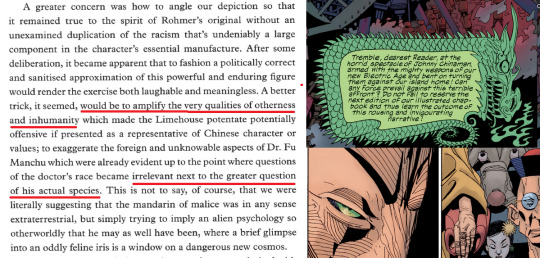
(text comes from an essay Alan Moore wrote regarding his usage of Fu Manchu in the book, which was scanned and sent to me by @mirrorfalls, thank you for that.)
The LOEG's first enemy is Fu Manchu and the book sure likes depicting leering hordes of yellow peril cartoons for our heroes, Mr Hyde in particular, to brutally mow down. Alan Moore thought the genius trick to making Fu Manchu not-racist was to make him as inscrutable and sinister as possible so as to not even appear human, which is a great understanding of how racial caricatures work guys, the "not potentially offensive" shirt has people asking a lot of questions answered by it.
I've heard a lot of claims over the years that LOEG was intended to be a parody, or satire, and that it's using Fu Manchu to make a point as a criticism of the British Empire and imperialism, and I'm gonna make this clear before we move on: LOEG is not a parody or satire, not as a whole. It parodies and satirizes a lot of things, but it is neither parody nor satire. It is very much in love with much of it's subject matter even when it wants to burn it down. LOEG is also a frankly terrible critique of imperialism, it is one of the most imperialist things I've ever read. Part of it is because you can't just recycle problematic garbage and claim it's commentary, especially when you're going out of your way to sensationalize said garbage to be provocative or in many cases add shit that wasn't even there in the first place. Moore asked if anyone else was gonna try and criticize colonialist bigotry in fiction by tripling down on reproducing it as hard as possible, and then didn't wait for an answer before doing it.
Volume 2: Objectively an improvement over the first if only because Fu Manchu isn't there. It's also where the book kinda improves in terms of making a critique. LOEG never really has much to say about it's characters, instead developing them in service of the story or social commentary, and Volume 2 is better at it than the first. Still has a lot of the same problems as 1, it's still a shallow team-up thing that wants to have it's cake and eat it too, it's still the worse version of a concept that's been done many many times before and after. Edward Hyde gets the bulk of the focus here and he was very clearly Moore and O'Neil's favorite character to work on, he gets the most memorable sequences for better or worse. I don't wanna talk about him much and I don't wanna talk about how the book wraps up the Invisible Man's subplot (and how it's not even gonna be the last time sexual violation of a villain is played for oh-so-horrific catharsis), I'd frankly like to stop thinking about it.
The Traveler's Almanac was definitely the most exhausting part to read in full and only not a total waste of time because of Jess Nevins' annotations, which turn this into fairly valuable research material. But so do Wold Newton articles and they're really not the most riveting thing to read, and at least those have a point or constrain themselves to a single topic or character, or are briefer and come with resources on hand or have a point or even can pitch some neat/cool ideas and concepts as a whole. Jess Nevins even did the better version of this in his own WNU chronologies.
Where as this is just complete ass and there's only so many times you can read a variant of "and then we went to this place with horrible cannibal savages and then we went to the other place with beautiful cannibal savages and then we found this utopia and then we found this dystopia and then we referenced this and that and this and that", and it brings me to another point I'd also seen brought up a lot in regards to LOEG: that it's too damn anglocentric to live up to it's premise, too contradictory within itself, and it was always too big of an undertaking to be done the way Moore and O'Neill did it.

I appreciate Moore trying to make this world feel like a world, in as gigantic all-encompassing a scale as he could possibly account for, with a full world tour and internal chronology. I sure would have liked a big fiction crossover almanac with entire chapters for Africa and China and South America, but we don't get that, because EVERYTHING in them is taken from colonial texts elevated to fact. Literally, entire paragraphs taken from political and colonial texts. All the time spent dicking around with all of those Euro political texts and ancient lore that just had to be paid it's due, and then Orlando goes to China and finds Sun Wukong stuffed as a public freakshow and dismisses his mythos as a bunch of loony (but intriguing and exotic!) hogwash, and Godzilla is later brought up in one line of dialogue to mention how Hugo Hercules killed him offscreen. (I think those might be the only two texts Moore brings up that aren't from European/American sources? There might be others but good luck finding them in the annotations).
Is it unfair to expect Moore to have read all of fiction? Of course it is, but that's what he wants this to be about, he wants this to be about All of Fiction and he wants to write about Africa and China and South America with nothing but colonial texts about those places as reference. He wants to write about how the things he likes are cool and happened and are real while the things he doesn't like don't count or are garbage or didn't happen the way we were told happened. He wants to make a story criticizing racism and misogyny in fiction while writing a text far more racist and misogynistic than most of the things he's bringing up. It's irreconcilable.
Black Dossier: It's constantly jumping between different formats and having to adjust it's prose and visual style accordingly, and it does that fairly well (the beatnik section is completely fucking unreadable though, the prose sections are already a handful to get through as is but that one was too much even for me), although Tempest I think is gonna do it much better. It's got some good parts, it's also got some bad ones. Definitely more readable than the prior two + Almanac.
This is the one with the Gollywog in it and I'm not gonna talk about that thing, I think what's wrong with it is self-explanatory as is. Look, I truly love a lot of Moore's work I've read, and I think a lot of the pushback against Alan Moore painting him as just a cranky old man who hates comics is overblown and shitty and symptomatic of bigger issues with how fans discuss comics and superheroes, but his defense of the Gollywog and his response to the criticisms of LOEG was embarassing and beneath him.
Century: This is the one with Harry Potter and The Lightning Penis in it. To those of you who heard at some point that Alan Moore had done a much-maligned pisstake on Harry Potter and got curious, don't get your hopes up. It's nothing, it's not even that mean, it's just a crude crayon doodle in service of a larger and very dumb critique of modern fiction that could have been anyone. Shame that he bullseyed ahead of the schedule the cultural about-face against Harry Potter without having anything actually criticizing Harry Potter to show for it.
Century does work for me a bit better because it dispenses with the pretense of the series and has it build up to the big awful tragedy it ends on, with all of it's remaining characters miserable immortals and all the fictions having curdled up and gone sour. It works for me only because I have no love whatsoever for this world and so it destroying our characters in the service of the larger narrative about stories and fictional immortality and whatnot is a decision I agree with and I think makes it stronger, even if the social commentary / the story's criticism of modern stories compared to the old ones is frankly absurd. Century I think was perceived as Moore/O'Neill having lost the plot, but to me it feels like the plot (more importantly, the point of it) finally showing up after so much pointless dicking around.
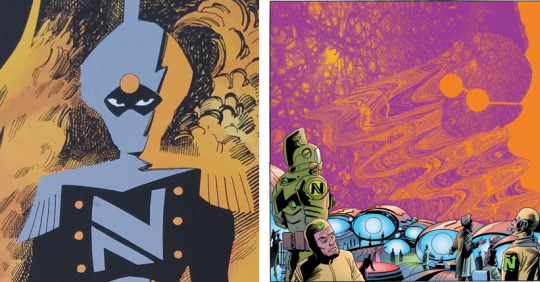
The Nemo trilogy: Easily the one I most enjoyed reading, the Nemo Trilogy is almost like a breather set in between books, just fairly straightforward pulp adventure stories done in far less rancid a fashion than Volume 1. It feels less like a LOEG book and more like one of those LOEG fanfics made by people who like the concept and characters but are dissappointed by the books, so they fill or add or rewrite in the blanks with their own ideas, which is basically every LOEG fanfic ever made. I quite like Janni Dakkar as a character and I'm already a huge mark for Captain Nemo, one of my favorite characters ever, and I was of course very glad to get away from the extremely tiresome Mina/Allan/Orlando trio for a change. Frankly I'd even recommend these as a standalone, they're so disconnected from everything else in LOEG.
If you guys want to read a comic take on Captain Nemo though, read Mobilis by Juni Ba. Infinitely better than anything Moore did with the concept of Nemo, takes far less pages to actually explore the character meaningfully and has far more interesting, more humane and personal things to say and do in general, one of the best things I ever read and a tremendous palette cleanser after LOEG.
Tempest: Tempest is what I'd call the best of the LOEG books, in terms of craft and in terms of achieving what it sets out to do. Namely, it's one of the most elaborate and most artistically impressive slowly unfurling middle fingers I'd ever read, Alan and Kevin in full burning down the house mode throwing everything they've got at the wall, playing around with as many different styles and gags and ideas as they can cram into the great apocalyptic ending of their collaboration. It's a very spiteful work that has a lot of joy and humor to it, fully divested from giving a shit about it's characters and instead recasting them as the bit players they always were in the grand fuckening of humanity at the hands of our fictions.

It gets to burn down everything and also preserve everything in a big dreamy Noah's Ark forever, it plays to every strength the series had, and frankly I barely minded the detours because this thing is all detours. The superhero parody that takes up so much of it isn't really anything funny or insightful or really anything, but there's good bits in it, and I like Alan Moore talking trash about superheroes (of course, it pales in comparison to What Can We Know About Thunderman, but that one is a league of it's own). It's Alan and Kevin's farewell to comics with all the mixed feelings towards it and the industry and the subject matter they both have decades of so much experience with it. It is The End of Everything and I think it ended on the best note it could have ended with.
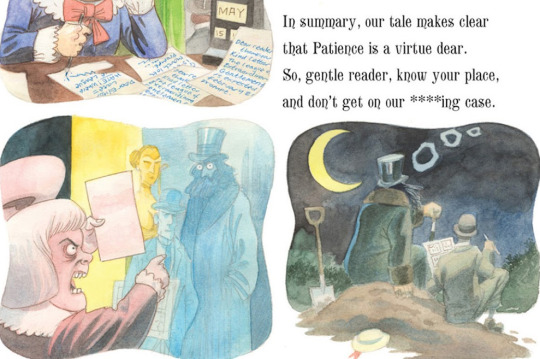
In summary, I think LOEG has a lot of individually cool or neat or even great ideas that I think get lost, because there is so, so much of it, and so much of it is impressively painted sludge. Sometimes it is ingenious, sometimes it is fun, it is never not visually impressive, but it's more frequently dull and grotesquely self-indulgent and far too shallow. It suffers from an almost inescapable side effect of doing this dealing with the fiction he was dealing with without accounting for taste or bothering to reign in his worst impulses, too much to cover and not enough actually being said about it. In truth, much of it doesn't feel much different than reading the wiki summaries for it I had already read forever ago. It is a unique beast taking swings that I'd never seen before that most wouldn't, probably for very good reasons most of the time. It is also guilty of literally everything it's criticizing other works of being and doing, and sometimes it actually provides it's best commentary because of that! It's a complicated thing to tackle and wrap your head around. God knows what Jess Nevins must have gone through to make the annotations for this, as they put it on the Almanac annotations.

I don't consider it wasted time because, I did really enjoy the final two installments, there are good bits scattered across the other books and I learned some good things from it as a whole, but would I recommend it in it's entirety? Unless you're really a huge fan or completionist for it's creators (although reading LOEG really disillusioned me on Moore in a lot of ways, not that this is a bad thing, if anything that's a necessary thing to really try and grasp a creator's body of work) or you're the kind of sicko who'd be in the tank for the whole thing, no, not really.
It is one of the most impressive and accomplished works I've ever read, I will probably come back to it for research purposes, but holy shit am I glad to put it behind me.

#also thank you davidmann for sending me the epilogue#replies tag#loeg#league of extraordinary gentlemen#alan moore#kevin o'neill#abc comics#comics
50 notes
·
View notes
Text
(Repost) How The Killing Joke ruined Batgirl

Note: This article was originally posted March 20th, 2015 on the Agony Booth, which I used to write for. Since that site is sadly no longer with us, I’m reposting my old articles here.
Alan Moore’s iconic graphic novel The Killing Joke is probably his most controversial work to date, and that’s saying something. It’s a great read, with some fantastic artwork that continues to influence and inspire the Batman franchise to this day. But along with the praise, over the years it’s attracted quite a bit of criticism from many sources (including its own author) for its callous maiming of the character of Barbara Gordon. The Killing Joke is one of comics’ most famous examples of “women in refrigerators”, a decade before the term was even coined.
The subject of The Killing Joke has again been raised recently by a controversial variant cover for Batgirl #41, which features the Joker menacing a petrified looking Batgirl while smearing a smile of what is presumably blood on her face. It was created, without the input or consent of the actual comic’s creative team, mind you, to help celebrate the 75th anniversary of the Joker’s first published appearance in 1940’s Batman #1.
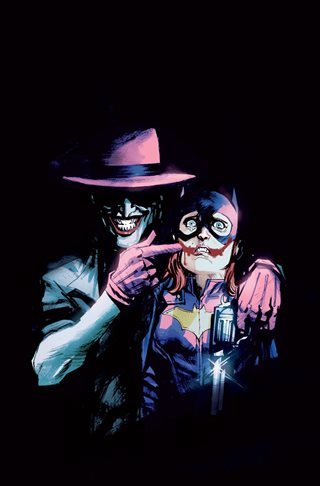
The cover drew immediate criticism, spawning the twitter hashtag #CHANGETHECOVER, and as of now, DC has officially pulled it, and will not be including it as one of the final published covers of the comic. Beyond the misogynistic undertones it conveys, the cover just plain doesn’t fit with the tone of the comic itself, which has been leaning in a much more fun, lighthearted direction under its new creative team, who all protested the cover immediately. Unfortunately, this wasn’t in time to stop a small army of angry readers online from making the cover’s cancellation their new pet cause, raising it up as a martyr to “self-censorship”.
I shouldn’t even have to explain this, but “self-censorship” is an oxymoron and doesn’t exist. You cannot, by definition, censor yourself, as censorship is something imposed on you by an outside party (such as, but not always, the government). A privately-owned company commissioning a work of art and then choosing not to sell it is called self-control.
On its own, the cover may seem relatively harmless. There’s certainly nothing wrong with celebrating the character of the Joker. He’s arguably the most popular character DC has right now, even more so than Batman. And the fact that they chose to reference The Killing Joke isn’t surprising—it’s probably the most famous Joker story ever written. However, while it may seem harmless out of context, in context, it comes across as rather disturbing.
When Alan Moore first made the decision to have the Joker cripple and sexually humiliate Barbara Gordon, DC was rather alarmingly unconcerned about it. You’d think they would be hesitant to take a character who was mainly known for being the colorful, fun sidekick created for the ‘60s TV show and do something that dark and mean-spirited to her. Instead, Moore’s editor Len Wein famously responded, “Yeah, okay, cripple the bitch.” Moore has made no secret of his regret over ever writing the scene and wishing in retrospect that they had said no.
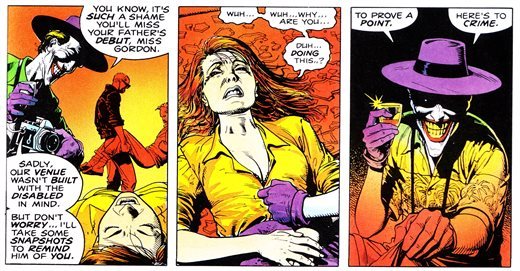
Fortunately, the character of Barbara Gordon did not end with The Killing Joke. Despite being paralyzed from the waist down, she returned to crime-fighting under the identity of “Oracle”, a secretive master hacker who provides tech support and intel to other heroes in the DC universe. In this capacity, she became a popular and important hero in her own right, free from Batman’s shadow, and even formed and led her own superhero team, the Birds of Prey.

Barbara continued on as Oracle for a few decades. Then came the New 52. When DC decided to reboot their entire universe of characters, they decided to make Barbara Gordon into Batgirl once more, bringing her back to her more iconic roots. That’s not a bad idea in theory. I enjoy the young, spunky, purple-suited Batgirl just as much as I like her as mysterious, badass Oracle.
However, they made a horrible miscalculation when they elected to keep The Killing Joke as part of her new continuity. She still got shot, molested, and possibly raped by the Joker; she just wasn’t crippled afterwards, and continued being Batgirl.
It’s understandable that DC wouldn’t want to write one of their most popular stories out of continuity (even though they had no problem writing out Alan Moore’s actual best DC story, “For the Man Who Has Everything”, thirty years ago during Crisis on Infinite Earths). However, keeping Killing Joke in continuity while removing Barbara’s rebirth as Oracle* trivializes the entire event as a part of her character. The idea that she could just bounce back like it never happened, without being profoundly changed by the experience, is at best childish and simpleminded.
[*By the way, I read somewhere that her history as Oracle is still supposed to be in continuity, but since she’s essentially back to square one regardless of what came in between, it hardly matters.]
That’s not to say Barbara isn’t still affected by The Killing Joke; quite the opposite. I only read the first few issues, but in those stories, New 52 Batgirl couldn’t stop talking about how not-over-it she was. Barbara was constantly suffering from PTSD, cowering at anything that even reminded her of the Joker. It’s a rather infantilizing step back from the Barbara who remade herself stronger than ever as Oracle.

Plus, on a personal note, the major appeal of Barbara as Batgirl, to me, was that she was the only Batman sidekick that wasn’t defined or motivated by some past tragedy. She became Batgirl because she wanted to, not because some random criminal killed her parents. Now she’s just as messed up as the rest of them.
By continually focusing on the lowest point in Barbara’s history, DC is refusing to let her move on, forever keeping her the scared little victim. They’re defining her by The Killing Joke, and The Killing Joke isn’t even her story. She has almost no dialogue in that comic, and her only role is to be maimed and degraded in order to traumatize her father, Commissioner Gordon.
Likewise, this cover is also not about Batgirl, not really, despite being a cover for her comic. It’s intended to be a celebration of the Joker. And choosing such a horrifying image as a celebration is in incredibly poor taste. It comes across as a glorification of Batgirl’s humiliation and degradation. It’s not like they couldn’t have given her a more empowering or even fun Joker-themed cover: The variant cover for Action Comics features Superman threatening the Clown Prince of Crime with heat vision. The Catwoman cover shows a Catwoman-branded giant boxing glove punching the Joker out. Even the covers that do show the Joker seemingly triumphant don’t show the heroes in such a infantilized, compromising position.
Defenders of the Batgirl variant cover are quick to point out that Batgirl is far from the Joker’s only famous victim, and there are plenty of times comics show male heroes in moments of defeat or weakness. This is true, but it’s almost never done this way. Male heroes, even in defeat, are almost always drawn to still look defiant and “cool”, keeping their dignity intact. You’d never see the same image with Batman in Batgirl’s place, with that same teary-eyed look of childlike horror. Case in point: the image below, with the Joker and Batgirl replaced by Doomsday and Superman:

This parody drawing by comic artist Ray Dillon perfectly illustrates the comics industry’s double standard. Male heroes are never allowed to seem this weak. The same image with a male hero instead of a female hero becomes laughably comical. Even if it weren’t, it still wouldn’t have the same impact, because The Death of Superman was nothing like The Killing Joke. Superman wasn’t fridged in one scene halfway through to further some other character’s story, and he wasn’t humiliated or violated. He was the central character, and he went out it a bloody blaze of glory, and took his assailant with him to the grave.
For a better example, let’s look at the Joker’s other most famous victim: Jason Todd, the second Robin. Famously beaten to death with a crowbar by the Joker in the storyline A Death in the Family, Jason eventually returned from the dead. Despite having arguably more reason than Barbara to fear the Joker and experience PTSD over his encounter, there mysteriously seems to be little in the way of art or storylines to that effect. Nothing comparable to this variant cover featuring Jason Todd with the Joker exists, that I’ve seen.
Jason Todd’s post-resurrection stories haven’t been about fear: they’ve been about anger. Jason’s been out for revenge ever since he rose from the dead. His stories are all about how badass and vengeful he is now. He doesn’t cower in fear every time someone pulls out a crowbar—he turned around and beat the Joker half to death with a crowbar. (Not that I want to see Batgirl shoot the Joker through the spine, but at least it’d be better than having her live in constant fear.)
And even putting that aside, Jason didn’t get nearly the short end of the stick in A Death in the Family that Barbara did in The Killing Joke. Once again, Death in the Family was Jason’s story. He had agency, and his actions drove the plot. Even in his final moments, he had more control than Barbara did, with his last act being throwing his body in the way of an explosion in a futile attempt to save his mom.
Showing a female character as scared or victimized doesn’t have to be a bad thing. For example, there’s one comic book all about a woman being brutalized by the Joker that I absolutely love and would have no problem with DC revisiting: Paul Dini’s Mad Love. Why? Because Mad Love is 100% Harley Quinn’s story. She drives the plot, she has the arc. And her victimization isn’t just there for its own sake, or for the sake of Batman or the Joker; it informs her character and the story and it teaches something. That’s the difference between the Joker defenestrating Harley and crippling Barbara. One is all about the victim, while the other is all about the victimizer.
3 notes
·
View notes
Note
It’s been very enlightening to read your posts on cultural appropriation. I still have one question though: what’s your opinion on artists and writers using concepts from other cultures in their work? Is using mythology, concepts and ideas from other cultures in one’s artistic work (properly researched or otherwise) as disrespectful and offensive as practicing rituals and traditions that you are not born in to? For example, Alan Moore’s Promethea is basically a didactic graphic novel introducing people to the concepts of the Tree of Life & Kabbalah, but from a Western ceremonial magick viewpoint rather than a strictly closed Jewish tradition. I found it an extremely inspiring work. And after some further research and further encounters with the terminology in an aristic/philosophical context by Grant Morrison, I used some Tree Of Life references in my work because no other motif seemed to fit better. Now I have found out that Kabbalah is considered a closed tradition and that Moore and Morrison may have crossed lines referencing traditions they researched only as esoteric occultists rather than members of the original group, I kinda don’t know what to do now. I always felt like learning about other cultures and referencing them as accurately as possible was a good way of preventing total eurocentrism, but now I am wondering if socially conscious white writers can only ever use christianity, norse or Ancient Greek & Roman mythology and traditions if we don’t want to make people from other cultures feel disrespected.
This is a really good and interesting question!! This is kinda long, but I think the answer really depends on how it’s handled.
I don’t think being inspired by other cultures and traditions is a bad thing at all, there’s such a huge plethora of different practices out there and all of them can be beautiful, interesting, and inspiring! Of course they are! So how are they incorporating it and to what degree? Is the material being handled with genuine love and care, or did they just cop the aesthetic to appear more mystical/demonic/exotic/etc.? Are they taking inspiration and creating something original and unique of their own, or are they portraying themselves as experts on the real subject/experience? Are they working with any members of the culture/tradition? Are those people being credited and compensated for their labor? All of those things can make a difference in how respectful or disrespectful something is, you know?
Important to note, though, is that there are already creative people within these traditions and cultures telling their stories, making their art, and sharing their voices. Preventing total eurocentrism isn’t about just letting white culturally christian writers expand their own storytelling; it’s about supporting and uplifting more diverse creators! I don’t have one on hand but I know there are several lists of fantasy novels written by POC, and many authors will have lovingly-crafted stories with their own culture as the backbone. Diversity in authorship is really where the solution to Eurocentrism in fiction lies, imo. For the rest of us, writing respectful and diverse characters is always still a good thing to do.
Back on track though- if something in another culture inspires you in a creative way, you can still let that creativity flow! But talking to members of that culture will always be the best way to figure out if you’re being respectful. There’s no one-size-fits-all answer to that, you know? Some things won’t be a problem at all, others might. No shame in just asking to be sure. :)
And if a show or book you like misses the mark, it’s okay to still enjoy it and find meaning in it, it just means that now you’re looking at it with a mature and critical eye and recognizing it isn’t perfect, which is good and normal. ^^
38 notes
·
View notes
Text
It’s Summer And We’re Running Out Of Ice - Watchmen (TV Series) blog
(SPOILER WARNING: The following is an in-depth critical analysis. if you haven’t seen this episode yet, you may want to before reading this review)
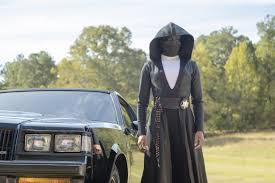
I’m not going to lie. I was incredibly sceptical going into this. This isn’t the first TV adaptation of a classic novel to go beyond the source material and try to continue the story, and they nearly always suck (see The Handmaid’s Tale and The Man In The High Castle). There’s a reason why books end where they’re supposed to end. If the author intended to carry the story on, they would have done so. This is why I get angry when the TV industry arrogantly oversteps the mark and try to continue a plot that has already come to a satisfactory conclusion. Doing a sequel to Watchmen, a story that hinges on the ambiguity of its ending, is just utter madness to me, and allowing Damon Lindelof to write that sequel borders on moronic at first glance. This is the man behind the TV series Lost, a show that ran out of steam within the first couple of episodes due to the fact that the plot was complete and total bollocks and the fact that nobody could be bothered to come up with satisfying answers for these ludicrous mysteries and series arcs beforehand. They were just making that shit up as he went along. Now you’re handing Lindelof the keys to one of the most intricate and detailed comic book properties of all time?! Fuck, why don’t you just let JJ Abrams direct the next Star Wars mo- Oh yeah, I forgot, he already did that.
Thankfully, judging by this first episode anyway, HBO’s Watchmen is nowhere near as bad as Lost. It’s certainly far more engaging and coherent. Does that mean I’m looking forward to the rest of this season? Well... I don’t know if I’d go that far. I’m definitely intrigued though.
HBO’s Watchmen is a sequel to the graphic novel (Lindelof called it a remix, but come on. Grow a pair and call it what it is. A sequel). Superheroes are still illegal, Robert Redford is now the President, Rorschach’s death has inspired a white supremacist cult, and it’s raining squid.
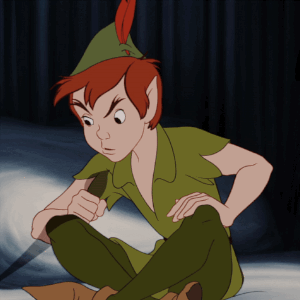
Yeah, the raining squid thing feels like the only egregious bit of fanwank in here, to be fair. Maybe they’re going somewhere with this, but I have my doubts. Are we supposed to assume that Ozymandias has been making squid rain for the past thirty odd years in order to keep up the whole alien invasion ruse? Why squid rain? And why is everyone so nonchalant about it? Shouldn’t people be just a bit concerned by this, considering what happened in New York?
Speaking of Ozymandias, we see him riding a horse and writing plays for his butler and maid in some fancy mansion. Quite what the significance of The Watchmaker’s Son is, I don’t know. All I do know is I’m not going to be able to sleep at night without thinking about Jeremy Irons’ thighs from now on, so thanks for that.
Putting my cynicism aside for a moment, I do like what Lindelof is trying to do here. He’s not merely cashing in on the Watchmen brand. There is a genuine effort to do something fresh and different with this material, and I commend that. Watchmen’s central theme has always been about power, but whereas the source material focused mainly on its relation to sex (Comedian’s hedonism, Nite Owl’s impotence, Rorschach’s mummy issues and the sexual objectification of Silk Spectre), the TV series seems to be zeroing in on race as a topic. This I applaud. Expanding on certain areas that the graphic novel only ever really touched upon is a great idea. This doesn’t feel like a repeat of the graphic novel, but rather a clarification of it, exploring areas and themes that Alan Moore and Dave Gibbons may have overlooked. This helps set this series apart from the outset.
The opening scenes where we see the Tulsa Massacre of 1921 is a pretty harrowing way to start. I’m ashamed to say I had no idea about the Tulsa Massacre prior to this, and we could have a whole other discussion about why schools seem to have been avoiding teaching specific topics like this in favour of the broad strokes of the Jim Crow era, but now is not the time. The fact that it’s depicted here sets the stage for what’s to come. Some have criticised the show for the length of time the opening focuses on Tulsa, claiming that it sensationalises the pain of black people at that time. I personally don’t think it does. It’s not overly graphic or gratuitous, at least in my opinion, but it is a very shocking way to open a series. Some might say even upsetting, but I think it’s important that we saw this because it’s relevant in setting the tone for the episode and indeed the season as a whole, as well as letting the audience know that this show isn’t going to fuck around or shy away from more sensitive topics, and I can respect that. Unlike Zack Snyder’s overly stylised adaptation from 2009, Watchmen the HBO series is grounded very firmly in reality.

Let’s discuss characters. This episode mostly focuses on Angela Abar, also known as Sister Night. Regina King has given some terrific performances in the past and this is no exception. She’s simply phenomenal. The way she switches from light-hearted wife and baker to violent, no nonsense vigilante cop. The shift is noticeable and yet both personas feel like they’re aspects of the same character. It’s exceptionally good. It also helps that the character herself makes for a great protagonist. Having survived the ‘White Night’ four years prior, where the Seventh Kavalry attacked the families of forty Tulsa police officers in response to the government giving special reparations to the victims of racial injustice, Angela has become cynical and battle hardened. She has no sympathy for Kavlary members and is willing to skip due process by beating one of them to a pulp and bundling him in the back of her car. She’s angry and in pain, and yet retains the audience's sympathy. I’m interested to see what happens to her over the course of the season.
I also really liked her friendship with Don Johnson’s character Judd Crawford. Johnson is a charismatic performer and Crawford is a charismatic character. He really dives into the olde western sheriff persona and seems to be having a lot of fun with it. Crawford is the only other character, besides Angela, who stayed on as a police officer after the White Night, and the two characters seem to have a great relationship. They laugh and joke around and there’s clearly a mutual respect between the two. I genuinely like this character, which is what makes his murder at the end so much more heartbreaking. Not to mention all the little details that force us to realise he may not be what he seems. We see him sniff cocaine in private and there’s a photo on his desk featuring the kid from school who aggressively asked Angela why black people deserve reparations. It doesn’t necessarily mean that Crawford himself is racist, but there’s clearly more going on with him that we don’t know about.
The final character of interest at the moment is Tim Blake Nelson’s character Wade Tillman, aka Looking Glass. We don’t know anything about him yet other than he’s a human lie detector, which I find very intriguing and I hope will be explored further as the show goes on. There’s a lot to play around with there, and the moral implications are tantalising. A conviction based not on physical evidence, but rather on the observations of one man. Even Sherlock Holmes has to back his deductions up with evidence, and yet Looking Glass clearly doesn’t need to. That just raises so many ethical questions. What if he has a particular bias towards someone? What about burden of proof? What if forensic evidence contradicts him? If Looking Glass is supposedly that accurate, does that mean the police will side with him regardless? It’s a great premise for a character and I really like Nelson’s performance, giving him a cold and detached personality that contrasts beautifully with Angela’s.
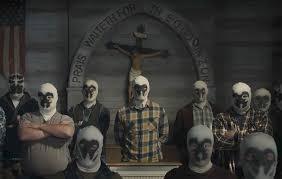
The characters and ideas are solid, however where I feel the show is lacking is with the consistency of its world building. Let’s analyse. This is an alternate history where Nixon used superheroes to extend his term limits, but after the New York attack at the end of the graphic novel, he’s been kicked out in favour of Robert Redford (nice nod to the source material there by the way. lol). As a result, black people got reparations for the racial injustices their ancestors went through and police are now unable to openly carry firearms without special permission from Panda (literally a cop wearing a panda costume). However, after the events of White Night, the government agrees to allow cops to wear masks to protect their identities, hence why quote/unquote ‘superheroes’ like Sister Night and Looking Glass are around despite the existence of the Keene Act. These are, in effect, legal vigilantes. Except already there’s a problem with conflicting messages. I like the idea of masked cops. In the current age of Black Lives Matter and police accountability, it makes sense and could be interesting to explore. However this is hindered by the whole ‘no guns’ stuff. Again, not a bad idea. America’s current gun laws are, to put it mildly, woefully inadequate. What if we went the other way? What if not only was it near impossible to own a gun, cops couldn’t even use a taser without special permission. Both ideas could work... but not at the same time.
Cops being allowed to wear masks creates the effect of empowering them through anonymity, and runs the risk of officers overstepping the mark and normal citizens being unable to hold them to account. But on the other hand, we’ve also got cops whose lives are constantly at risk and who are hindered in their duties by an overprotective nanny state, which effectively depowers them. So... which is it? It can’t be both. I like the scene where Panda reads the law about how the use of firearms can only be permitted in extreme circumstances, and everyone just angrily shouts him down because it tells us how the police feel about this new system. The fact that they’ve made one cop the sole arbiter of these new restrictions and forced him to dress like some ridiculous furry demonstrates the sheer amount of disdain they have towards this policy. But having said that, with the masks on, they have the power and freedom to break into people’s caravans and basically kidnap and assault them without consequence anyway. So what the fuck are they complaining about? It just doesn’t gel together. Either have it that the rules and regulations of the police are the same as our world except that cops can wear masks now, which has led to an increasing problem of police brutality and corruption, or have it that the police are being too heavily restricted and so a few have chosen to turn toward more ‘unorthodox’ methods of crime fighting out of frustration. Pick one and go with it.
Then there’s the Seventh Kavalry. Again, not a bad idea. In fact I love it. A white supremacist cult that’s taken Rorschach’s journal as gospel and have banded together out of a fear of being sidelined in a more liberal world. Very relevant and very interesting. Except... well... there’s not an awful lot to it, is there? In the original graphic novel, there was no clear bad guy. Ozymandias believed he was doing the ultimate good by killing millions of people to save the world, and everyone reluctantly went along with it. It was morally complicated. This, not so much. They’re unambiguously evil. The end. So what? What is there to discuss? It just feels lacking compared to the graphic novel and it runs the risk of creating a conflict that’s too clear cut. Obviously we’re going to end up siding with the cops, regardless of what they do, because the alternative is objectively bad. Hopefully Lindelof is going somewhere with this, but I’d be remiss if I didn’t say I was slightly concerned.
So on the whole, would I say I enjoyed this first episode? Well... I’d say I did, but with reservations. There’s some good characters and ideas that could be interesting to explore and develop, but its execution feels a little shaky in places. Hopefully the episodes to come will offer further clarity.
#it's summer and we're running out of ice#watchmen#watchmen hbo#damon lindelof#dc#hbo#review#spoilers
23 notes
·
View notes
Text
One Bad Day - League of Villains
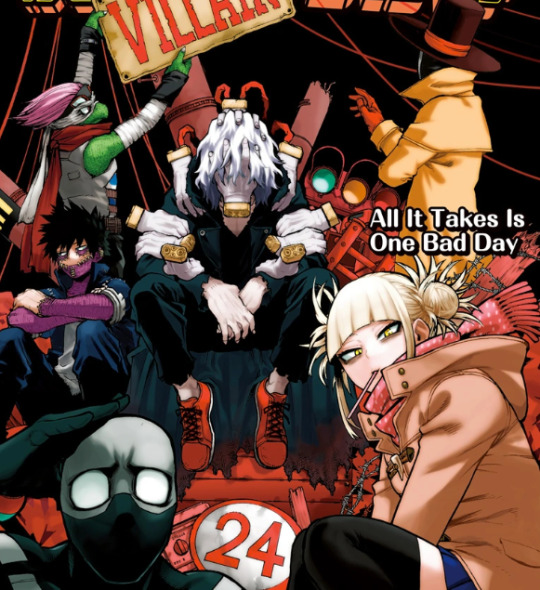
can you explain the meaning of all it takes is one bad day meaning my hero academia? I saw it used with twice but i thought that it might appy to some of the villians we saw in the manga.
In the most recent arc “My Villain Academia” the story flipped to the villain’s side rather than the heroes and we saw the world through their eyes. In that same arc, Hori made several allusions to The Killing Joke by Alan Moore, a comic that explores a darker take on the relationship between batman and the joker and one potential take on the Joker’s Character. It just like My Villain Academia is a story told mainly through the villain’s eyes rather than the hero’s, and it’s all about the narrative a villain tells himself.
What was Hori’s purpose in referencing the killing joke? Did he take inspiration from the story? Is he just a nerd making a comic book reference? Did he believes the themes espoused in the Killing Joke to be true? Let’s take a look under the cut.
1. The Killing Joke
The most logical place to start is with the material Horikoshi is referencing himself. I read the Killing Joke several years ago, and reread it for the purpose of this meta. The funny thing about the killing joke (har har) as it’s one of those stories that gets misinterpreted a lot by fans.
It’s actually a pet peeve of mine when people blame the original work itself, like saying it’s Fight Club’s fault that people misread it. The common misreading of the text is that Joker is right, that he’s actually this really deep person that sees through the lies of society. Even when the entire point of the story is that Joker is wrong, the characters even say this out loud as direct dialogue. This story is the exact opposite of subtle, it’s very in your face with it’s themes, almost too loud.
People confuse the Joker’s own personal narrative, that he sees through these things and is therefore deeper and more aware than anybody else, with the framing of the story that frames Joker as petty and shallow. But, you could have Joker wear a t-shirt that says “I am wrong and a hypocrite” the entire work and people would still misread it.
The point of this preamble being, I don’t think Hori misinterpreted the killing Joke. I do not think his reading of the story is so shallow he referenced it because the joker is a cool villain who says cool things. I hope that will show as I continue, that there is a lot of thought put into these connections. Even if it’s not a direct adaptation of the themes of the killing work the two separate works make for a really interesting comparison.

Joker says many things about the world., but the killing Joke isn’t about the world at all, nor does Joker really care about the world. The Killing Joke is not a comment on society, it’s a character study, primarily about the relationship between Batman and the Joker. It starts and ends with the titular killing joke.
See, there were these two guys in a lunatic asylum, and one night, one night they decide they don’t like living in the asylum anymore. They decide they’re going to escape. So, like, they get up on the roof and there, just across this narrow gap, they see the rooftops of the town stretching away in the moonlight, stretching away to freedom. Now, the first guy, he jumps right across with no problem but his friend, his friend daredn’t make the leap, y’see. Y’see he’s afraid of falling. So then the first guy has an idea. He says “Hey, I have my flashlight with me. I’ll shine it across the gape between the buildings. You can walk along the beam and join me.” But the second guy just shakes his head. He suh-says. He says “wh-what do you think I am, crazy? You’d turn it off when I was halfway across.”
The Joker's joke, which is an analogy of how hopeless it is for one insane man to try saving another insane man. It's so sadly relevant, Batman can't help but join the Monster in bitter laughter. The entire story is a character study of the foiling between Batman and the Joker, and how both of their actions, becoming a hero, becoming a villain, is a response to meaningless tragedy in their lives. Yet, even if Batman recognizes that they’re both victims in a way he can’t save joker, because it’s impossible for one insane man to save another.
That is the main theme, of the Killing Joke. In a way it’s a failure of empathy, because batman’s methods won’t save the joker, punching him in the face won’t fix him. That is also what I believe Horikoshi disagrees with.
The main conflict of the Killing Joke is that the Joker is trying to make a point. That he’s not that different from everybody else, that anyobdy when exposed to the meaningless tragedy of the world would go insane. That it’s the right response and everybody else, clinging to to society, and it’s made up rules are the ones who are really man.
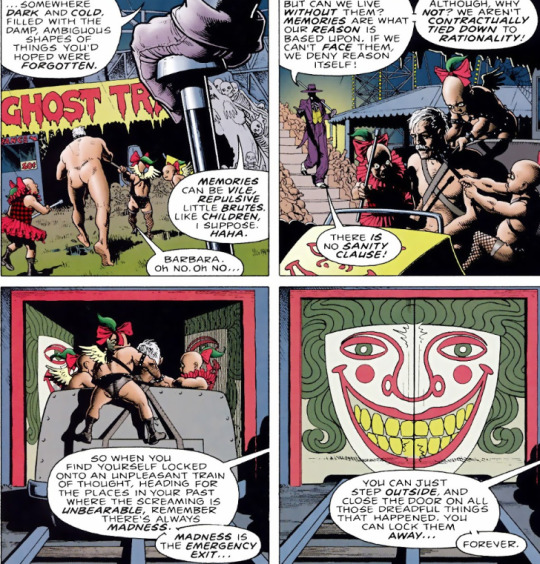
It’s basically what is called moral nihilism.
Moral nihilism is the meta-ethical view that ethical claims are generall false. It holds that there are no objective moral facts, or true propositions - that nothing is morally good, bad, right, wrong, because there are no moral truths.
Basically, because morals are made up ideas by human beings therefore morals cannot exist. The thing is while it insists there is no value to the things we believe are proper and right about the world, it’s not Nihilism or not in the nietzschian sense of the word.
See, the thing is Joker is right that all of these institutions are meaningless, that they’re not as set in stone as humans would like to pretend they are, that the earth under your feet could fall out under you at any time.
But that realization is not necessarily something that leads to evil, or even madness. Like, nihilism is very subversive of power structures. People use the idea of meaning, they use ideas, they use the way the world currently is as unfair as it is to insist that the world has always been that way, to keep in power. Therefore, rejecting what you are told by existing power structures and finding their words meaningless and thinking critically instead is something that could lead into something better. The formation of new ideas inevitably involves the rejection of old ones as meaningless.

However, the joker isn’t interested in any of that. Nothing he says is subversive of power structures at all. He doesn’t care about the injustice of the world, or the way power structures let people like him fall through the cracks. In fact, Joker recreates the same power structures he is trying so hard to subvert and laugh at.

Joker’s entire (possible?) backstory is that he was a victim of poverty that the world didn’t really care about, was utterly indifferent to, and the realization of the world’s indifference to him is what drove him mad in the end. However, the thing about the Joker is, he sucks at telling jokes. His attempted parody or satire just ends up recreating the same ideas of the society he is trying so hard to say that he’s above.
In his backstory, the Joker makes a pretty misogynist joke. While a victim of poverty himself, he looks down on women victims of poverty who sell their own bodies and try to live just like he is. Joker’s problem isn’t society itself, it’s that he’s the one being stepped on, and not the one stepping on others because he thinks it should be the other way around. A guy like him should have never ended up society’s victim, society’s punchline.

Which is why he insists that he’s normal. He’s the same as everybody else. And in a way he’s right, Joker reflects the attitudes of society, he’s sexist, he looks down at the poor, it’s implied he takes his feelings of inferiority out on his wife. He’s normal for all of those reasons, not because it would be normal to go insane.

Also, this is just a side tangent but there’s a lot of philosophy on whether normal people are good or bad which is too lengthy to get into, but whether people are born good or bad by default, normal people will carry within them the ideas society raised them in.
“You must stop your fooling around with women. You’ve gone far enough. Society won’t stand for more.”
What, I wondered, did he mean by “Society?” The plural of human beings?
No longer Human, Osamu Dazai.
Society is the plural of human beings. Joker is a part of the same society, a reflection of the same society, a response to it, just like any other person is, and in that way he’s normal and not as outside of society as he believes himself to be.
The work then goes on to make the point that while this may be our society, there are also people who try to be better even in situations like these. Gordon the entire time, tells Batman it’s wrong even if Joker is a bad person who murders people, to beat him up because police brutality is wrong.

So we finally reach the scene which Hori is quoting. Joker’s speech to Batman, the grand point that he is trying to prove. That everybody is the same as he is, they just haven’t realized it yet. That anybody would have gone mad being put through what he was put through, the revelation that everything was meaningless.


However, once again Joker doesn’t actually care whether society is meaningless or not. In fact, his actions are the opposite of NIhilism. He is trying to make a point. A point, as in, the opposite of meaninglessness. He thinks there are ideas that are correct, that there’s such a thing as being right about this world.
Which is why we see is his slow breakdown amidst his own monologue. What he really wants is to prove to someone else his perspective is correct. So that he can finally feel justified in it, and maybe because batman isn’t responding he has to pause a minute and consider that he’s wrong?

What Joker fears is true meaninglessness. So everything he does isn’t reveling in meaninglessness like he supposes, it’s the opposite of it. He’s trying to create a narrative to life, he’s trying to give it themes, he wants to teach a lesson. Joker’s views are just a reflection of the society that created him. Joker thinks everybody else is wrong, but the idea that he himself might be wrong genuinely breaks him.
Which is why Batman’s line here is so important. Because I’ve heard it before. What Joker says is no different from society. He carries the same attitudes. Society isn’t just some idea floating out there, it’s made up of human beings, people like the Joker.

So, the work of the Killing Joke itself is subversive to the idea that one bad day is all it takes to turn anyone into a villain. However, at the same time the Killing Joke is not trying to make a point about society, or insanity, or victimhood and trauma or anything like that. All of those ideas present in the work, but they are basically just window dressing because the central part of the story is a character study between Joker and Batman, two people who let their entire lives be ruined by one bad day.

However, at the same time Killing Joke is heavily flawed. Just like the joker is misogynist, etc. etc, the work itself is rife with the nineties it was made in. On that front it’s much more a product of its time than ahead of its time in any signficiant way. Like, there’s the obvious fridging of Barbara Gordon, but also as I said the point they are trying to make isn’t reflective of mental illness or trauma or anything like that. The joker went mad because he was a bad person to begin with.
See the thing is I also believe that mentally ill people are perfectly capable of being bad people at the same time. There’s nuance there. No Longer Human, by Osamu Dazai is an example of this. The main character isn’t a bad person because they are mentally ill. The fact that they are a victim of trauma never goes away throughout the book. Yet at the same time, you see the person just uses other people as things for them to cope with, they could care less about the feelings of others, they see no one else as an individual. The way they cope with their mental illness when they are given access to healthier alternatives, is what makes them a bad person.
While yes that is also a part of the Joker’s character, he’s always been double sided as a bully, as someone who is looking for an excuse to exploit others not really to make any kind of point. Which is why the ideas of mental illness and victimhood and whether society is at fault for creating people like this by the act of letting people fall through the cracks isn’t really suited to a character like the joker. This is something Alan Moore himself admits.
I’ve never really liked my story in The Killing Joke. I think it put far too much melodramatic weight upon a character that was never designed to carry it. It was too nasty, it was too physically violent. There were some good things about it, but in terms of my writing, it’s not one of me favorite pieces.
“Alan Moore”
There are a lot of ideas about society brought up in the Killing Joke, but none of them are substantial, and none of them really matter because the work itself is not trying to develop them.
However, the ideas themselves are still good which is why I like to think Hori’s work in My Hero Academia, his insistence that one bad day is what created people like Shigaraki, Twice, and Redestro is not a misinterpretation of Alan Moore’s message but in fact an interesting response.
2. Shigaraki’s Bad Day
There are a lot of connections between Shigaraki, the character and the Joker for instance, it’s pointed out right a way in the same sense as the Joker is throughout the entire Killing Joke comic, that he does not really mean what he says and he isn’t actually trying to prove any kind of point through his actions.
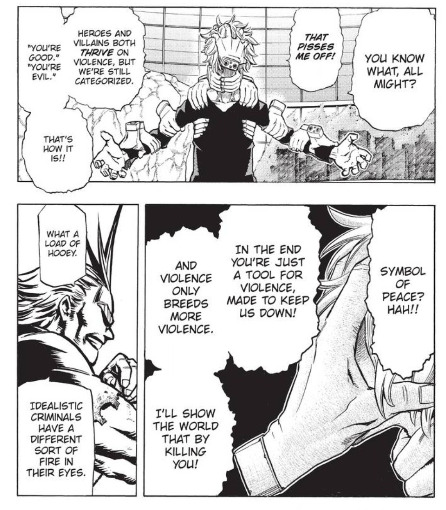
However, Horikoshi’s writing and humanization of Shigaraki is really different and takes a different direction than the Joker. Here let’s talk about good victim bad victim again.
The reason good victim bad victim is bad, because it basically tries to strip away victimhood of characters in order to render them in black and white ways. It gives the implication that reacting certain ways to trauma makes you a bad person. The feelings of the victim are entirely stripped away and they’re stopped from being seen as a human being, because other people want to fit them into a simpler black and white narrative.
Nuance is the best way to approach these scenes. So, let’s look at this scene with what we now know. Shigaraki is a victim of abuse. Not only that but he became a punching bag for his father, directly because All Might’s Master abandoned his father to raise All Might Instead. He was raised in domestic violence, and then adopted by a violent person and molded into becoming more violent raised with no stability, no home and constantly exposed to danger that would threaten his life.
So, yes Shigaraki’s words might be nonsense but the feelings behind them are still real. This is what All Might’s Mistake is, he could not care any less about the feelings that the person he is fighting has, and he just sees them as someone to punch in the face. This is also something that bites him later when he realizes that Shigaraki actually was someone he was connected to.
Of course All Might is trying to save a bunch of kids, does he really have time to listen to the feelings of somebody threatening to kill kids? Who knows. That’s the thing about reality, it is mesy and indefinite, there are more important questions to ask then whether victims are good or bad. You could also say at the same time that All Might is completely oblivious to the feelings of victims of abuse. That he still fails to see what kind of person Endeavor is, and insists he has good things to teach people, because Endeavor is a part of the same sytem that heroes is.
Anyway, the point of that tangent was to establish a good aspect of Hori’s writing, characters are people first. Shigaraki is a victim first before the question of whether he is a good person or a bad person is even asked.

Shigaraki is also, someone like the joker thinks he seees above society because he sees it from an outsider’s perspective. He views other people as clinging onto meaningless ideals and unable to see or think for themselves, because they’re too concerned with the illusion of safety.
Shigaraki also shares the same relationship with Deku that the joker does with Batman. Even though they do not know or understand each other, the two of them are set up as mortal enemies and keep fighting each other because their masters pushed them into this fight. Deku even denounces Shigaraki the same way that Batman does the Joker.

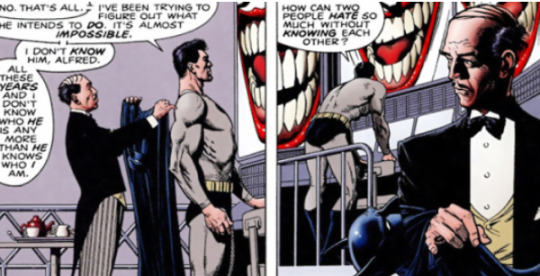
Shigaraki and the joker both experience a moment where they snap. Almost as if their entire lives have been defined by one bad day, where a lot of it amounted to coincidence. Joker loses his whole family in one day and falls in the chemical tank, Tenko’s quirk activates after a particularly bad day of abuse in his abusive household and his family is caught up in an accident, and then when his father attacks him he tries to defend himself.

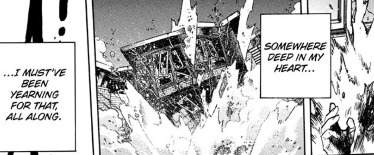
Here is the primary difference though. With Joker there’s the idea written that Joker was like that all along, that he wanted to hurt people and take out his shitty life on others, and that his madness just revealed feelings that were already there. This mostly works in the case of the joker because he’s a bully, a bad person, that’s who he’s always been.
But, Shigaraki is 1) five years old, and 2) we see the kind of person Shigaraki is before trauma.
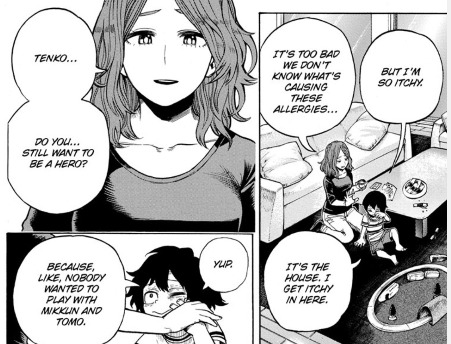

He’s a kid who is in fact, victimized by the patriarchical ideas of society. Unlike the joker who believed he deserved more, not only was Tenko literally just a kid trying to be himself and follow his own dream who was abused by patriarchical authority figure in his own house, but Tenko even as a victim still cared about the feelings of other people, fellow people who were being excluded like him and he went out of his way to look out for them.
There are absolutely no hints that Tenko was simply a bad person all along, and that he was looking for the excuse to simply act on his impulses to hurt other people and destroy things. In fact this idea itself appears in story as a narrative that All for One feeds him in order to manipulate. The Joker’s ideas appear in the story, but the one that uses them, the one that’s just a bully taking advantage of weaker people is All for One, not Shigaraki.
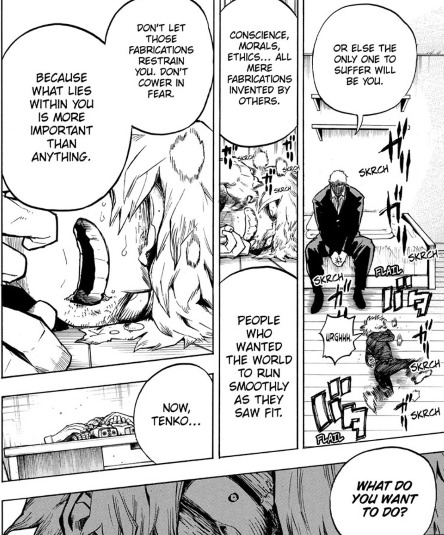
Shigaraki is deliberately raised not to have empathy for others, to only act on his own impulsive feelings to destroy, to be impulsive, to act to hurt whoever he wants, whenever he wants.
Now, I don’t know if there are truly good or evil people in this world. Good and evil might not even be real, but, at the same time jerks are real, and they’re out there in the world being jerks. For the sake of simplicity let’s just define a jerk as somebody who does not care about the feelings of other people in the least, especially when it comes secondary to their own feelings. Shigaraki does not fit that criteria.




Shigaraki listens to the people around him, he treats them with care. Even though Shigaraki suffered one bad day, and then several bad days after that, the part of Shigaraki that All for One tried so hard to destroy where he actually wants to reach out and connect to others and stand up for them is still there.
So, in a way Horikoshi is using Shigaraki for a much more empathic take of one bad day, which sort of validates both sides of the argument. Yes, someone’s entire life can be ruined by one day and they can fall through the cracks that easily and the society that was supposed to take care of them won’t. It’s a stance that acknowledges that villains are made, and trauma exists and will always affect people whether they are good or bad people.
However, at the same time that does not necessarily mean the person you are will be gone forever. One bad day cannot destroy you. The Joker’s view is pessimistic because he believes there’s no hope for someone like him, that both he and batman are completely broken and will have their lifes defined by their one bad day their entire life. Whereas, not only are the good parts fo Shigaraki still in there, but he also is someone slowly recovering from his trauma when placed in a much healthier environment. The Shigaraki at the beginning of the manga, and the Shigaraki we know now are different, because Shigaraki does not want to be stuck in one bad day his whole life, he’s trying desperately to become his own person outside of his trauma.
In the end, one bad day can in fact ruin your entire life. Which is why the message of the Killing Joke ends up coming off as a little ableist, by saying that if you were a good person you would not have let it ruin you. It’s kind of like saying that Dabi is a bad person because he chose to be a villain in response to Endeavor’s abuse, even though Shouto was abused and chose to become a hero. Like, that’s a pointless argument to make, and holds Dabi accountable for his own abuse instead of holding Endeavor accountable for the people he abused.
Shigaraki isn’t the joker, because Shigaraki is a lot more human than the joker as a character.
2. Twice’s Bad Day
The other fundamental difference between the Joker and The League of VIllains is that the Joker really is not trying to make any kind of anti-establishment point, nor does he really care about the society around him, whereas the League of Villains definitely does care. The Killing Joke isn’t actually about society, but My Hero Academia, the central conflict of the story is about the society the story takes place in, a society that basically manufactures it’s own villains.

Twice, just like the joker, and just like Shigaraki is someone who is driven insane by one bad day. Specifically because society as a whole neglected him and let him fall through the cracks. He’s also like the joker, someone who while at the same time as being insane, genuinely is able to observe the world around him from an outsider’s viewpoint and pick up on things. He tends to be more aware than the other characters, even while babbling like he’s just comedic relief.

However, Twice’s views are also in direct contrast with the Joker’s. Twice himself believes that it’s fine that normal people are able to enjoy their normal everyday lives, and that people exist in this society who have no problem fitting in at all.
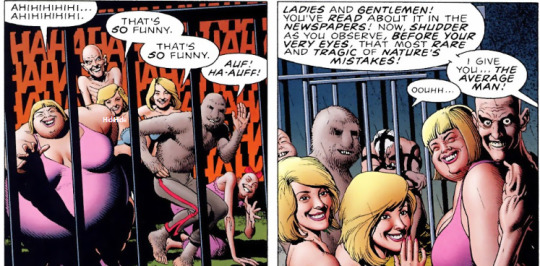
Whereas, the joker loathes normal people and anyobdy else who can fit into society in a way that he cannot. He dismisses them all as idiots and laughs at them. That’s because, as a character Twice is far more self aware, unlike the Joker who is in denial of his want for people to understand him that’s exactly what Twice wants and admits to wanting. He knows his views are outside of normal society, so instead of trying to prove that he’s right, Twice seeks out people who are like him.

He also knows that society will not try to save or sympathize with a person like his. The thing is the things Twice is saying aren’t grandiose claims to the true meaning of the world or seeing through everything, instead they’re much more grounded observations that are true because My Hero Academia is trying to prove a society that has failed people like Twice.
Twice’s story even mirrors the joker in several ways. He is basically the same, a guy down on his luck, dealing with poverty who eventually resorts to crime when all of his other options fall through.
Let us count the actual societal injustices that are present in Twice’s Backstory. Twice obeyed the law, and the person he hit did not. However, because the person he hit was a rich person and Twice was not, Twice was the one who was punished instead. Almost as if laws that supposedly protect everybody favor rich people and people with power already.

The foster system left Twice alone when his parents died from a villain attack.

Not only is Jin given a permanent record which affects all of his future employment because society treats felons like they are not people, but rather a lower class, but he also was fired from his job because someone abused the power they had in society to carry out a personal grudge against Twice. That person got away scott free and Twice lost his entire livelihood.

Twice retaliates and he turns to crime in order to survive, and yes there were better ways that Twice could have responded, but the only reason that Twice was put into the situation in the first place was several abuses of power in society directed towards him. People like to insist over and over again that victims should always just remain good people forever, without lashing out, or hurting others in order to survive but then not say how they are supposed to survive in those situations.
Twice however, takes full responsibility for his actions and realizes that his lashing out, his decision to live selfishly and steal and try to live the good life abusing his quirk was not what he wanted at all. His actions result directly in his bad day.

However, Twice too is given an option to recover. All it takes is one bad day, and anyone can become a villain is not the Joker trying to point in the context of My Hero Academia, it’s a statement of empathy. That Twice, Shigaraki are not alone in their trauma. That they are both able to find each other, and start to see themselves as human when they realize they were people driven to be this way and not bad people who were always this way. In Horikoshi’s writing it becomes a much more humanizing statement.
The sense of understanding that Joker is depserately trying to find in batman by proving a point, by forcing him to see the world this way, Twice and Shigaraki find in each other.


The Joker’s descent into madness is sign that he is permanently broken, whereas when Twice imitates that same pose and expression it’s used in a moment of healing for him. It’s him realizing broken as he is, he’s still here, he survived his one bad day.
As a final note, while portraying this humanizing message Horikoshi also manages to succesfully illsutrate the original point of the killing joke as well. It’s almost like having multiple examples of mental illness present in your stories, you can better explore the more negative reactions to mental ilness as well without coming off as ablist.
The commentary that Joker is a part of the society he thinks himself better in, that he repeats what he’s trying to subvert, that he entirely fails at sattire is something that is repeated in Rikiya.
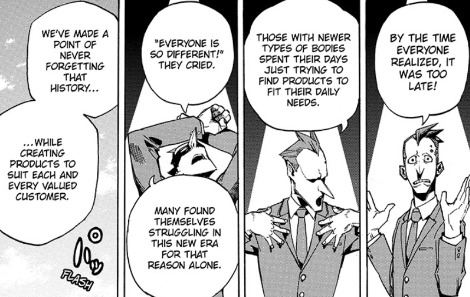

Rikiya and Joker are both capable of observing the society around them. They know the society around them is wrong. RIkiya’s ideals as Re-Destro that people should not be judged by their quirks and that quirk society as a whole tends to restrict people entirely based on their quirks, something that they are born with and cannot control, and that society should be trying to adapt to people and change rather than just putting certain people down for the benefit of the people who can fit in better.
However, both the joker and Rikiya are shown explicity not really to have attachment to the other people around them, or see them as people. They are jerks. Rikiya sees people as dispoable sacrifices to his great goal of reforming society.

Rikiya however speaks of how evil society’s prejudgices is, and then he goes and repeats them. He looks down on the league of villains for being poor and disabled when he himself is a wealthy businessman. He suggests that Shigaraki is uneducated as an insult to put him in his place.
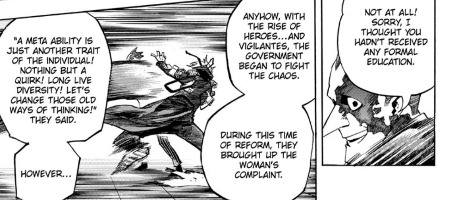
His followers who espouse how people should not be judged by their meta abilities, judge the league as worthless and unworthy people because of their quirks.

Destro says not to judge people by their quirks, and then goes and immediately insists that Shigaraki can only be a bad person who wants to destroy people, because he happened to be born that way.

Re-Destro claims to be anti-establishment, but not only does Rikiya thrive in this exact kind of society (he’s a wealthy businessman he’s on the top of society, punching down at people who fell through cracks and were living as genuinely homeless going day to day for survival), but even if he were succesful at destroying the current society his ideals would just recreate the same unbalanced society just with him at the top.
Rikiya would create a society where people are still discriminated on based by their quirks, he would create a society where people with stronger, flashier, quirks are able to have more freedom in life, and find more success and people with weaker quirks cannot amount to anything. How is that any different from the society he’s a part of?
Rikiya is a part of the society he is trying to destroy. Yet, even he is still a victim in a way, he was raised in a cult to think that way and told that he had to believe these things because of who his father was, and he’s constantly at conflict with himself because of it.
Rikiya, Shigaraki, and Twice in addition to other members of the League of Villains who fell through the cracks, all of these characters read as responses to different aspects of the jokers character and different ideas he presented in The Killing Joke. Rather than just a reference though, it is an intelligent response, that Horikoshi clearly made these ideas his own and shows off his priorities in wanting us as the audience to forget that these characters we call villains are human first.

In the end the Killing Joke and My Villain Academia play with the same ideas to come to different conclusions. The Killing Joke ends with the idea that an insane person cannot save another insane person. Batman cannot save the joker. The joker is not someone who can be saved, and at the realization of that batman starts to strangle him and gives into his worst instincts to commit police brutality.
My Hero Academia uses those same ideas to tell a story where insane people can save other insane people. Unlike Batman and the Joker, I genuinely believe that Horikoshi is writing towards a conclusion where Shigaraki is someone who can be saved by Deku, not someone he is meant to continually fight with until one of them dies or the other.
In the end they are two different stories one of them illsutrates a failure of empathy and the other illustrates how empathy among insane people brought them together.
#mha meta#lov meta#shigaraki meta#shigaraki tomura#jin bubaigawara#twice#yotsubasa rikiya#league of villains meta#league of villains#the killing joke#my hero academia#my hero acadmeia meta#my hero academia theory#my hero academia analysis#meta
227 notes
·
View notes
Text
In Two Minds: the polymorphous proficiency of Jonathan Miller
Sir Jonathan Miller was precocious polymath. Pretty much all the tributes to Jonathan Miller, who died aged 85 on 27 November 2019, end up using the term “Renaissance Man” at some point. Miller had a mastery of arts and science that few achieve. He was a doctor who specialised in neurology, a satirist, comedian, television broadcaster and writer, and theatre and opera director in which his transformative productions of classic plays and operas made him one of the most admired, as well as one of the most controversial, figures in the late-twentieth century theatre and opera.

Jonathan Wolfe Miller was born in 1934 in London. His father, Emanuel, was a child psychiatrist and his mother, Betty, a novelist and biographer. He had a sister, Sarah, who died in 2006. He attended St Paul’s, an independent day school, where he formed an intellectually precocious triumvirate with Oliver Sacks, later renowned as a neurologist and author, and Eric Korn, the writer and antiquarian bookseller. The three remained firm friends until Korn died in 2014 (Sacks died a year later). At Cambridge, Miller was a member of the Apostles, an exclusive intellectual club, as well as Footlights, the dramatic society.
Miller studied medicine at Cambridge University where he was a member of the Apostles, an exclusive invitation only intellectual club (past members included Bertrand Russell, Wittgenstein, John Maynard Keynes, Rupert Brooke, E.M. Forster, as well as more notoriously the infamous Cambridge spies, Anthony Blunt and Guy Burgess).
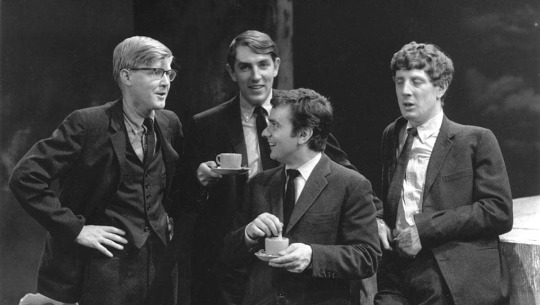
It was at Cambridge that he also joined the Cambridge Footlights, the university’s legendary theatrical comedy club, and performed in the club’s Footlights revues. Miller’s success as a Footlights star in the 1950s brought him to the attention of the producers of a new comedy stage revue, Beyond the Fringe, which opened in Edinburgh in August 1960. Subsequent transfers to London’s West End (1961) and to Broadway (1962) made Miller and his three Oxbridge educated co-stars - Alan Bennett, Peter Cook and Dudley Moore - instant celebrities.
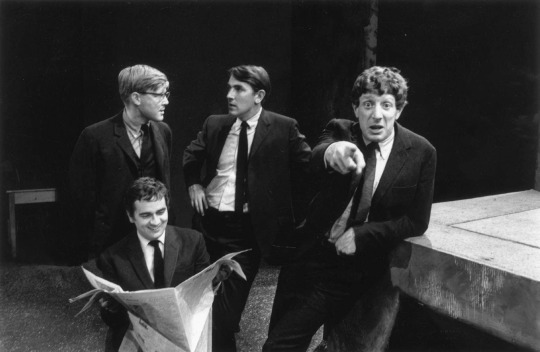
Beyond the Fringe was in the vanguard of a new generation chipping at the walls of the establishment and poking fun at the rigid pomposity of british class and society in the 1960s. In many ways Beyond the Fringe pioneered a path for the next generation of Oxbridge satirists, Monty Python, to take up the baton and beat it over the head of the establishment.
Miller, who qualified as a doctor in 1959 and maintained a special interest in neurology and neuropsychology, returned periodically to the practice of medicine, but spent most of his working life as a stage and opera director.

Miller’s first directing assignment was John Osborne’s Under Plain Cover in 1962. Miller made his U.S. directing debut in 1964 with The Old Glory, a play by poet Robert Lowell that inaugurated Off-Broadway’s American Place Theater.
Within a few years, Miller’s work at Nottingham Playhouse and other venues brought him to the attention of Laurence Olivier, then the head of the National Theatre. Miller’s memorable productions at the National, where he was an associate director during the Olivier years, included The Merchant of Venice, set in nineteenth-century Venice with Olivier as a top-hatted Shylock, and The School for Scandal. In 1974, Miller directed a season of three thematically linked plays at London’s Greenwich Theatre, presenting Hamlet, Ghosts and The Seagull as “Family Romances” and using the same actors for each play. Miller later served a two-year term as artistic director of the Old Vic in London (1988–90).
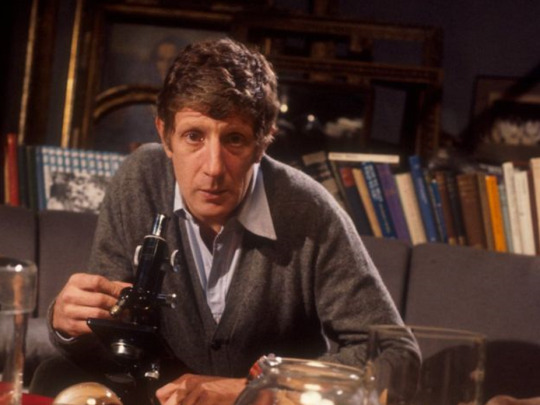
At his best, Miller had no equal for wit, originality or sheer invention as a director, especially in pieces that engaged his passion for storytelling fully; Miller’s universally admired brilliance as a conversationalist made him a coveted talk-show guest in both the U.K. and the U.S.
Miller was also a compelling television writer and presenter, with the documentary series The Body in Question (1979) and Madness (1991) among his credits. When he was in mid-career, Miller began to balance his work in the theater with directing opera—despite the fact that he never learned to read music. Miller’s opera productions were manifestly intelligent and well-informed, but occasionally overbusy, loaded with cultural references and staging touches that did little to advance the action—or support the music.
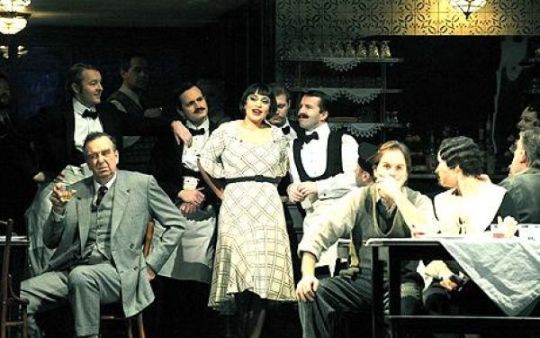
Miller’s first opera production was the 1974 British premiere of Alexander Goehr’s Arden Must Die at Sadler’s Wells Theatre in London; Alan Blyth, writing in Opera, called Miller’s production “severe, and in the end, debilitating.” The Goehr opera was to be one of the few contemporary pieces that Miller directed: in opera, as well as in the theater, he preferred to work on the production of classic works or the occasional rarity. Miller made his Glyndebourne debut in 1975, with the company premiere of Janáček’s Cunning Little Vixen.
He had especially fruitful working relationships with Kent Opera, where he directed a wide variety of repertory, including Così Fan Tutte, Falstaff, La Traviata, Eugene Onegin and Monteverdi’s L'Orfeo.
The British company with which Miller was most closely associated was English National Opera (ENO), which offered a gala celebration of his work with the company in 2016. At ENO, Miller’s vividly detailed stagings included La Bohème, Aida, The Barber of Seville, Carmen, Der Rosenkavalier, La Traviataand The Elixir of Love. Miller’s biggest ENO successes were his popular “Little Italy” staging of Rigoletto (1982) and a re-imagining of The Mikado (1986) that set Gilbert and Sullivan’s Japanese-themed operetta in an English resort hotel; both were presented in the U.S. and have been have been revived in London and elsewhere numerous times. Miller bowed at Covent Garden in 1993, with a modern-dress staging of Così Fan Tutte.
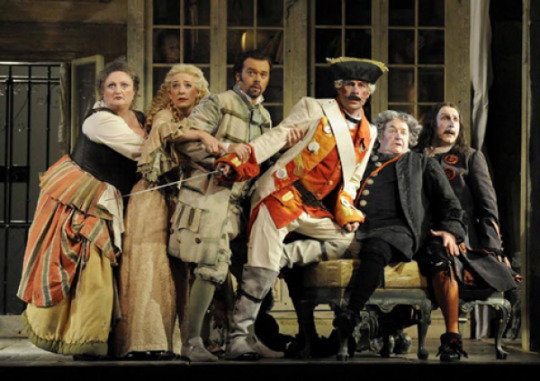
Miller made his U.S. opera debut in 1982, directing Così Fan Tutte for Opera Theatre of Saint Louis. His other North American productions included Bach’s St. Matthew Passion at BAM; La Traviata at Glimmerglass Opera and New York City Opera, Eugene Onegin at Santa Fe Opera, La Bohème at Cincinnati Opera, Così Fan Tutte in Washington, D.C. and Tristan und Isolde in Los Angeles. In Europe, Miller directed La Traviata for Paris Opéra, Der Fliegende Holländer in Frankfurt and a Fascist-era staging of Tosca in Florence. On Broadway, Miller directed Jack Lemmon and Kevin Spacey in Long Day’s Journey Into Night (1986) and Christopher Plummer in King Lear (2004).
Miller directed four operas for the Met. His 1991 staging of Janáček’s Kát’a Kabanová was an unqualified success - a stark, stylized vision of the opera’s harrowing emotional world, designed by Robert Israel and Gil Wechsler. The critical and response to Miller’s other Met stagings—Pelléas et Mélisande (1995), The Rake’s Progress (1997) and Le Nozze di Figaro (1998)—was generally positive, but Miller’s outspoken criticism of what he saw as the Met’s lack of support for him damaged his relationship with the company, and he was never given another new production there.
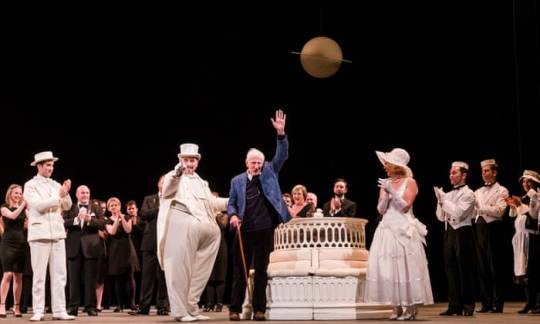
His style of directing especially opera revolved around two maxims, “One is constantly fighting a battle between two forms of idiocy,” he said of the business of opera directing, the first being “mindless traditionalism” and the second the requirement that “the work be relevant to our time”.
As a theatre director, mostly at the National Theatre in London, he sought to avoid those two forms of idiocy when directing Shakespeare, which he did for the BBC in the early 1980s. A production of a Shakespeare play, Miller thought, should not try to preserve it in the aspic of spurious authenticity.
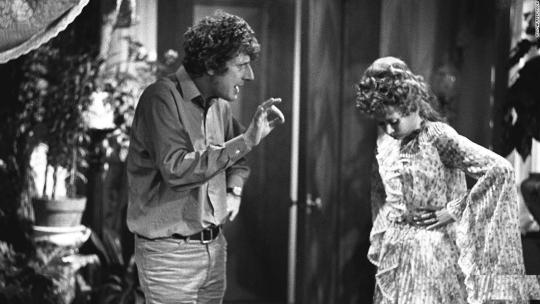
Miller was a lifelong atheist and in 2006 he was appointed president of the Rationalist Association. Accepting the appointment, he said: “There is a large unrepresented constituency of people for whom religion doesn’t enter their heads.” But while his atheism was unbending, it was not militant. Miller maintained that the job of this “community” of unbelievers was not to extirpate religious beliefs but to “analyse them with an objective curiosity and a kind of anthropological attitude to what people do”.
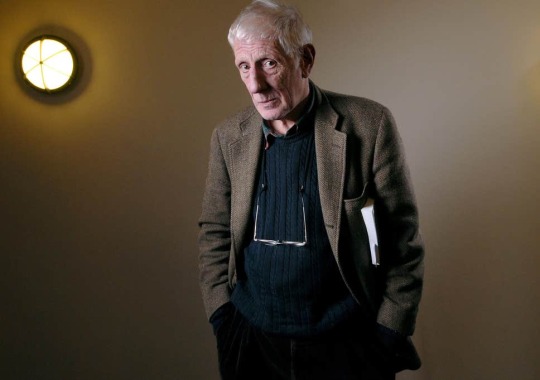
Miller displayed that intellectual humility and profound curiosity in everything he did. Indeed he once said, “I wasn't driven into medicine by a social conscience but by rampant curiosity.“ The same drive he said for his artistic pursuits. Kate Bassett called her informative 2012 biography of Miller In Two Minds, which captured this split in his life. Miller was haunted by his decision to abandon the medical profession where he had hoped to excel.
Ironically Miller rejected the oft-applied title “Renaissance man"as a “vulgar journalistic slogan”. He would argue that, “What they’re really saying is I’m a jack of all trades and a master of none.” He may have felt that “this footling flibbertigibbet world of theatre” was a distraction from higher pursuits - which is to say, the use of his Cambridge medical degree but these twin artistic and scientific interests seemed less opposed than complementary. If, as is said in “The Body in Question,” “by acting in and upon the world we remodel our own image in it,” everybody’s in show business, anyway.

To my mind, Miller’s arts and science background enabled him to cross disciplinary boundaries and make exciting connections and open new creative possibilities. He was the perfect riposte to that very British Two Cultures intellectual debate (1959-62) between F.R. Leavis and C.P. Snow, which focused on the lack of conversation between arts and science. If we consider how scholars now embrace interdisciplinarity, we should note that Miller blazed the trail. Miller should also be viewed as one of the architects of liberal Britain in the post-war period. He rejoiced in being an irreverent free thinker. And we should rejoice at having had the privilege of peeking into the polymorphic proficient mind(s) of one of this century’s creative and most curiousity driven of men.
I had the privilege of having meeting him on one or two occasions. Twice over dinner through my parents who were active patrons of the arts.
One of my older sisters is a neurologist and we were placed either side of him. Jonathan was ever so affable and down to earth. He immediately set about making us laugh with his forensic wit and life observations. Between courses he would flit (not a typo, he didn’t flirt) between my sister and myself. With her he would talk shop about neurology and the latest scientific breakthroughs and with me we talked about opera, theatre, and the classics.

The funny thing was as the evening wore on his kinetic mind was a speeding race car and he suddenly forgot which lane he was driving in i.e. he forgot to whom he was speaking to between the two of us. So he would speak about realism theatre of Euripides with my older sister and neurological disorders with me. My older sister - I hate to admit this in print because she will lorde it over me until the end of days - was educated and eloquent enough to keep the conversation effortlessly flowing.
I would like to say that I too upped my game and rose to such elevated heights of scientific discourse but alas I fell like Icarus...but faster, as my mind felt like lead balloon tied to a one ton dead weight. I fell hard. He could see the tumbleweeds rolling across my vacant mind through my clueless eyes. Ever the gentleman he steered me to more friendly topics like the psychology of killing as I was seriously torn between going Sandhurst to become an army officer or returning to Cambridge to do a PhD. I saw him once or twice after that in other private settings and I always came away glowing because I learned some new curioisity about our human condition and the artistic ways we express the human condition in all its foibles and pathos.
RIP Jonathan Miller.
30 notes
·
View notes
Text
Movie Review: Joker
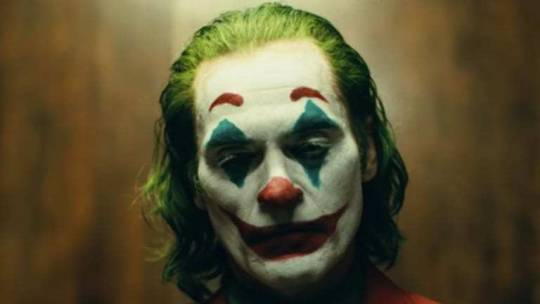
The Joker is ubiquitous in pop culture, possibly second only to his nemesis. If there is a Batman-adjacent project, the Joker will show up at some point, and often be the most memorable element. That’s held true for portrayals by Cesar Romero, Mark Hamill, Jack Nicholson and Heath Ledger. Joaquin Phoenix’s turn in the role takes a different tack and makes the villain the central character. It does not make him the hero, and that is an important distinction. Todd Phillips’ film walks a thin line between exploration of the character and adoration of him, and manages to stay upright.
There will, of course, be debate about that, a thing which in and of itself speaks to the unique creature the film is: can you imagine walking out of Avengers and debating anything other than which moments were the most fan-pleasing? I did that after Endgame, and was, on a superficial level, satisfied. Joker is aiming for a more cerebral level. There were times I could see the point and times I could not. That alone is noteworthy. I can’t imagine feeling philosophically conflicted about most superhero films. Is it possible I am giving it bonus credit simply for having thoughts in a typically thoughtless genre? Entirely possible.
One thing I noted is that when the credits roll, Phoenix is not credited as the Joker, but as Arthur Fleck. Fleck is a clown-for-hire who dreams of being a stand-up comedian, but keeps the lights on, barely, for himself and his mother by spinning sale signs or cheering up sick children. We meet him as he is mugged by a group of teenagers for no reason; they break the sign he is twirling, and his boss insists he stole it. His life is a series of such incidents, a pattern of trusting the world will do the right thing and finding it won’t. You sense that, deep down, he knows this. He reacts to each new disappointment not with shock or anger but with simple, resigned acceptance.
His life is one of quiet drudgery leading inevitably to a pauper’s grave, and it is dominated by his mother, played by Frances Conroy, who I have personally not seen since she was owning the brilliant Six Feet Under. We meet her here as a defeated old woman, gazing lovingly at TV interviews being given by Mayoral candidate Thomas Wayne (Brett Cullen) whose attitude toward the poor is derived from the real-world remarks of many right-wing politicians mixed with the savior-ism of the left. She worked for him, years ago, and is convinced he will answer her letters and lift her and her son out of poverty. This is one of several places where the film breaks with society’s stereotypes of the down-and-out: Fleck lives with his mother and does his best to care for her despite his own limitations, and the situation is not seen as especially pathetic. Another is that Fleck is regularly single, but being unlucky in love isn’t a significant contribution to his transformation; a brief relationship with a single mother (Zazie Beets) ends sadly but is not greatly important to his fall.
That transformation is played out slowly, and there’s no one moment that allows us to go “A-ha! This is it!” He discovers things about his true parentage, and then discovers there may be even more secrets to those secrets. He learns his mother may not be all there, and is keeping things from him. A moment is needed to highlight Conroy, who must shift her persona a couple of times during the film. We’ve all likely known an older woman who is oddly obsessed with something she’s seen on television; it has become a cliche, and most cliches have some basis in fact. Conroy feels sympathetic, and yet when we learn she may be unstable and possibly abusive, we also believe it; there is more than one person in her.

The film’s world views are not what Outrage Culture decided ahead of time that they would be. Prior to the film’s release, there were those who watched the trailer and decided it was glorifying sexist societal outcasts and the acts of violence they sometimes carry out. If you go into the movie expecting it to be that, you can probably find evidence of it. For myself, I don’t subscribe to the notion of deciding what a film I have not seen is and is not. I’ve seen it now, and as with almost every film that addresses mental illness in any way, there are things it does well and things it does less well. The slow transmutation of a simple sad sack into a mad anarchist is movie-plausible, if not real-life-plausible. Phillips and co-writer Scott Silver use some convenient shortcuts to let us know how close to the line Arthur is. He’s on seven medications and asks for more; more crazy, of course, requires more pills. He is gaunt and skeletal, with Phoenix losing a lot of weight for the role, to the point where his joints seem misplaced; another shorthand, as you rarely see a character who is both mentally ill and has any meat on their bones. There’s still a basic idea that external forces are needed to produce a real breakdown; the idea it can just simply happen, due to imagined events or to nothing at all, is simply too opaque for a visual medium to capture. The drama concerning Fleck’s parentage veers just this side of soap opera, but rights itself in the end. This is set against a backdrop of economic unrest, and the eventual furor the Joker stirs up resembles Occupy Wall Street on steroids.
What the film gets right is the way most people who end up suffering from a damaged mind get that way not because of one bad day---the cause Joker famously attributes his origin to in Alan Moore’s classic graphic novel The Killing Joke---but because of the slow accumulation of wounds that by themselves would not be serious, or would not be serious to someone with a different brain. The most tone-deaf criticism I have heard is that the things that happen to Fleck are not realistic; that they are contrived simply to make him sympathetic. If someone believes that people are not casually cruel for no reason, I would venture to say they have lived a charmed life. As someone who has spent time in both retail wars and the vastly overhyped halls of many a Comic Convention, I didn’t find anything people did to Fleck to be beyond belief. Robert De Niro plays a late night host who mocks Fleck’s botched attempt at stand-up to score cheap laughs of his own, and that of course is found everywhere. It is, for instance, easy to write a negative review by personally attacking the people involved. The film is not denying that some people are just horrible. Rather, it is saying that maybe, just maybe, the casual cruelty and anger that is so easy to find doesn’t help. We are also, of course, not meant to sympathize with the path Fleck takes, but to recognize that when people are monstrous, they create monsters.
There are criticisms that can be leveled at Joker, and since this is a positive review, I obviously disagree with most of them. Yet one stands out: the idea that the movie glorifies a murderer. There are ample movies and TV shows picturing the common fantasy of not taking it anymore, in which good guys kill anyone and everyone who looks at them funny while obliterating huge parts of the world around them. People die at the hands of heroes for doing their jobs on the regular, and how many innocent bystanders do so when Iron Man rips through downtown New York? Those movies reduce such sequences to cartoons, so we may go away satisfied and empty-headed. The greatest perspective trick movies often pull is not any camera wizardry, but in convincing us that psychopathic mass murderers are heroes. Will Joker start a new wave in film of Watchmen-like introspection on the reality of worlds full of colorful people with powers? Certainly not; we like our candy too much. Yet I will continue to dream of a Batman film in which the question asked is not why Joker kills, but why Batman keeps letting him escape to do it.
Verdict: Recommended
Note: I don’t use stars, but here are my possible verdicts.
Must-See
Highly Recommended
Recommended
Average
Not Recommended
Avoid like the Plague
You can follow Ryan's reviews on Facebook here:
https://www.facebook.com/ryanmeftmovies/
Or his tweets here:
https://twitter.com/RyanmEft
All images are property of the people what own the movie.
#joker#Joaquin Phoenix#batman#heath ledger#movies#frances conroy#jack nicholson#mark hamill#cesar romero#todd phillips#brett cullen#DC comics#zazie beetz
35 notes
·
View notes
Text
Watchmen: My favorite show of 2019
Now that I’ve watched HBO’s Watchmen in its entirety, I can safely say that it is by far my favorite show I’ve seen this year. The more I think about it though, the less it seems to offer a coherent statement about vigilantism, power and violence the way the original graphic novel did. I don’t think this makes it any less clever, bold or satisfying to watch, but Watchmen is more interested in playing with the weight and drama of themes than actually expressing a clear, useful thesis about them.
The show is a sequel to the graphic novel, taking place in 2019, when the fallout from the 1987 story finally comes home to roost.
To give you some more context, I’ll be talking about Alan Moore’s 1986-1987 maxiseries of comics first, and then comparing it to the new television series narratively. In terms of acting and production values, I’d say that the show is great across the board, although your mileage may vary. This is doubly true of its narrative: I’m curious if the show is too confusing for people who’ve never read the comic, and the show doesn’t show a lot of reverence for the characters of the original. In my opinion, this is for the best and actually completely in the spirit of Alan Moore’s work. From here on out, There be Spoilers for the comic, movie and the tv series.
Watchmen (1987) by Alan Moore and Dave Gibbons is by far my absolute favorite superhero comic. It is the only graphic novel to be named as one of Time’s 100 best novels of the twentieth century. It’s certainly not true that it is the only graphic novel that deserves that kind of honor, but it is not on that list for bad reasons. This post would be too long if I listed all of Watchmen’s many achievements, so I will just say this: Watchmen investigates how the existence of masked vigilantes and superheroes would change the real world, and its answer is not positive. No matter how you slice it, in order to inflict violence on strangers or save the world based purely on your own moral compass, you have to be either hopelessly naive or narcissistic, sadistic, fascistic, fetishist, manic, or untethered from human experience in one way or the other. However you imagine them, superheroes escalate danger. They are not cooperative or peace-loving by their nature, the comic says. ‘Superheroes’ will do terrible things in the name of ‘saving the world’ or ‘doing the right thing’. In this sense, the book is thoroughly anti-utopian but also anti-superhero, and it commits to this by depicting all of its ‘protagonists’ as deeply flawed, ultimately dangerous or inept people.
In terms of plot, the big twist that effects the show is that the smartest man in the world, the vigilante Ozymandias, predicts that nuclear armageddon is inevitable unless he convinces the global superpowers that there is a massive alien threat, making their feuds appear petty and risky by comparison. He literally kills millions of people with a genetically engineered giant monster that he teleports to New York, not including the dozens of murders to prepare the ground and cover up this fact. The fear that more monsters like this could appear prevents nuclear war at the last second, but another vigilante named Rorshach figured out Ozymandias’ plan and wanted to expose it, which would undo its intended peacemaking effect. He was killed, but his notes survived.
In the end, the only vigilante with actual superpowers, Dr. Manhattan, is so far removed from human experience because of his godlike powers and his nonlinear perception of time, that he seems to retreat from Earth itself, expressing a desire to create life elsewhere.
This is the backdrop against which Watchmen (2019) frames itself: what would that alternate history look like about 20 years later? But instead of focusing on the evils that vigilantism and superpowers would create, this sequel puts race and policing at the core of its narrative. The main protagonists: Angela Abar, Will Reeves, Laurie Blake and Wade Tillman are all cops and all of them are at one point in their lives masked vigilantes. They are also pitted against white supremacist terrorists, and the show depicts them as regularly violating the constitutional rights of suspects and killing lots of people in justifiable situations. The show depicts both cops and civilians in both real and historical race riots.
But the more I think about it, the less I can identify a coherent thesis about the origins or nature of racism or the morality of extra-judicial violence. It seems to say ‘violating a person’s human rights is alright as long as they’re racist’, and I mean, I can’t be too mad about that, but it also implies that the cops are basically good, that it is possible to root out specific racist conspiracies and that’s all that’s needed to set things right. There’s a definite assumption that most of the time, we can just trust cops to have integrity. The show rarely frames unmitigated violence as a systemic issue; even when the government is implicated. The protagonists are also relatable and sympathetic, and their victory against the white supremacist conspiracy is without any real moral complications or ironic personal costs. This show, unlike its source material, is pro-vigilante. Or at most neutral on the subject.
Its message about racism is more straightforward, but also a little hollow. Racist violence is shown viscerally, but also roundly condemed, ridiculed, and avenged by the protagonists. But that’s really as deep as it goes. All racists in this show are openly and stereotypically Southern whites. There is very little exploration or covert or insidious racism: there is a clear divide between literal neo-KKK types and antiracist avengers, with little ambiguity in between. We are not really shown what drives racists to be racist. The most motivation racists are given is a resentment over two attempts at improving the world: Reparations for the Tulsa Massacre, and the aforementioned plot to stop the Cold War by faking extradimensional invasion. Not that I’m begging for a humane portrayal of racist terrorists, but it does make it extremely easy for actual, less obvious white supremacists to ignore any criticism because ‘at least they’re not like the Seventh Kavalery’. It in short, doesn’t give viewers any special insight into racism and how to deal with it in the real world.
What Watchmen does do beautifully is representation. The first masked vigilante, Hooded Justice, who in the comic was a clear reference to a Klansman, is reimagined as the victim of a threatened lynching, who fights his attackers still wearing the noose and hood they put on him. He then pretends to be white to gain the support and cover he needs to be a vigilante. This man, Will Reeves, named himself after his childhood hero, the historical inspiration for the Lone Ranger, Bass Reeves. As a child, he was smuggled out from the Bombing of Tulsa in the trunk of a carriage, much like Moses or Superman. We later discover that HJ is bisexual and is essentially strung along for years by the media-savvy Captain Metropolis for publicity purposes and sex, and ends up desillusioned by his white allies. We also learn that Angela Abar, the de facto main character, is in fact his granddaughter, and she becomes involved in his decades-spanning plans to root out the racist conspiracy that the plot revolves around.
Perhaps even more interesting is the decision to integrate Doctor Manhattan into this sequel as a jewish and a black man. Rather than simply recasting the part, the show frames the revelation in a way that Dr. Manhattan might experience it: out of order, but also clearly telegraphed. The show uses this to characterize Dr. Manhattan as someone whose decisions do not adhere to standard causality. Why does he start to woo Angela Abar in the first place? Because from his perspective, he’s always been in love with her. Just like nothing ever ends, it doesn’t really begin from his perspective either. One day, he walks into A Bar and starts explaining to Angela Abar that they will be in a relationship for ten years, which wil then end in tragedy. While she is understandably skeptical, Regina King and Yahya Abdul-Mateen II really manage to sell both the frustrating absurdity and the transcendant romance of this idea. In the end, Osterman chooses to take the shape of a dead man based purely on the fact that Angela is most attracted to, and goes to great lengths to lose is powers and become human again, as a black man named Calvin Abar, who we first meet as Angela’s charming stay-at-home husband and father to their adopted children. The fact that he is Dr. Manhattan all along is revealed to us in my favorite sequence in the whole show. We, the audience, fall in love with both the husband as well as the God, Jon Osterman, as both are vulnerable and honest about who they are. Even though everyone knows it can’t last. These scenes are both heartbreaking and beautiful, and are foreshadowed masterfully from the beginning. This is what I mean when I say the show is clever.
The dialogue is witty and the cinematography, editing and plotting do a subtle job of worldbuilding. There are very few exposition dumps and characters rarely do or say things just to help the plot along; they are always driven by their own motivations rather than those the viewer might prefer in their hurry to learn more.
As a result, characters feel smart and their personalities and relationships develop more naturally. From Jeremy Irons’ Ozymandias to Hong Chau’s Lady Trieu to Jean Smart’s Laurie Blake, they all come across as clearly defined assholes with a charismatic competence.
The world and its history also unfold at their own pace. This can be confusing in the first couple of episodes. It isn’t explained why cops wear masks, what ‘Redfordations’ are, or why squids rain from the sky often enough that a siren goes off whenever it happens. Instead, viewers piece a lot of it together from context. The details make it feel very believable. It makes me feel like I’m discovering an alternate history the way a lost time traveler might.
In the end, it is not the themes that make this version of Watchmen so enjoyable. Its the intricate details of its world and the interactions between its characters that make Watchmen 2019 so fun to watch. And as far as on the nose messages go, ‘vaporize as many racists as possible‘ isn’t that bad.
#Watchmen 2019#Watchmen HBO#reviews#fave shows#fave show of 2019#Dr. Manhattan#Angela Abar#Hooded Justice#Cal Abar
8 notes
·
View notes
Text
Watchmans
It is 2018. I have been reading comics for over 20 years, and making them for about ten. I have never read Watchmen.
I even own the damn thing. I’m not sure when it got into my collection; it’s almost as if it was assigned to me when I started making comics where people fuck and say bad words. @beesmygod suggested that I ought to actually, you know, read the book. Assess how it’s aged. To make a long story short: it’s okay.
To make a short story long, I’ll break my assessment down into sections. People love that.
Art
It’s great. It’s not exciting, but it’s incredibly solid. It doesn’t feel “off”, while at the same time it never comes off as excessively referenced. The color palette can be jarring, and played a part in me not reading the book for a long time. I stopped noticing it after a while, and sometimes if you squint real hard and ignore the lineart, the colors look cool together in and of themselves. A notable exception: Nite Owl looks absolutely ridiculous without clothes on. It’s like Dave Gibbons got the script, read “chubby man” and thought, aw no, people hate looking at those. Nite Owl is the Ken Doll genitalia of Fat. It’s off-putting.
The comic makes great use of layouts, and pages always end on good narrative beats. Easy to follow (visually).
Story
Watchmen is what happens when a friend of yours tells you about some drama that’s clearly really exciting to them, but not to you. You don’t know the people involved. Your friend tells you everything that happened, and maybe even in the right order, but doesn’t tell you why you should care. That was the biggest issue for me, really: the story couldn’t convince me to invest in the characters. Is it because there are too many of them, so the focus is too broad? Is it that none of them are interesting people? The women in particular are boring in this comic, though at least the original Silk Spectre has a good line or two about Tijuana Bibles. I’d say that the women are less characters than props, but that would imply that the males had depth. Rorschach is the only character who, while not deep, has any weight to him at all.
There are a lot of references to the Cold War and Mutually Assured Destruction in this comic. There’s even a somewhat obscure reference to Nixon’s “Mad Bomber” strategy, which impressed me. Even so, I don’t feel like the comic makes the best use of the material. The threat of nuclear annihilation feels like background noise, even as the world encounters a potential crisis over the Soviet invasion of Afghanistan. This is more than a cosmetic issue, as the threat of annihilation is what drives the climax of the book. Going into Ozymandias’ big reveal, my initial response was, “Was this really necessary?” Things didn’t seem bad enough to warrant something so dramatic. Imagine what kind of shit he could’ve pulled if he was fully prepared for the Cuban missile crisis. What a drama queen. I assume this was an oversight; of all the criticism hurled at Ozymandias by the other characters, nobody tells him that he’s overreacting - just that they can’t believe he’s doing this “mad scientist shit”. When it’s done, they say, “All we did was fail to stop him from saving the world”. No, you failed to stop him from throwing a tanty. He didn’t save the world. It wasn’t in imminent danger in the first place.
All of that said, it’s not a terrible comic. It’s ambitious as all hell, which I respect. Is it a great comic? Well, we’ve collectively decided it is, so that means it is. Is it a great comic on its own merits, read in 2018? Not really. It has too much trouble with all of its moving parts, and knowing how to prioritize them properly to keep people focused. They even layer another comic in, a narrative-within-a-narrative. It’s an interesting affectation, but it doesn’t help with the impression of noise. It’s a real noisy comic.
On Rorschach
People have accused Watchmen of romanticizing the self-aggrandizing, tone-deaf attitude and behavior of Rorschach. A friend of mine believed he was an author insert. I think you’d have to assume the author really, really dislikes himself to believe that. Rorschach is not meant to be liked; he’s meant to set the book’s tone/thematic conflict, and he’s meant to be understood. In understanding him, you may find things about him that you do not hate. He isn’t even always wrong, which I think confuses some readers.
Rorschach is incredibly obnoxious. I think the author was pretty open about that. If you have to be beat over the head with constant declarations of how shitty a person is to be satisfied that the author isn’t glorifying being shitty, I just don’t know what to tell you.
On The Comedian
He’s like Dadaism if Dadaism was fascist, instead of the opposite of that. The shittiest nihilist. I don’t get him. Is he just there to suck? Why did anybody put up with this guy? Sure, he moves the plot along, but otherwise, man. Why are you here.
Moral relativism
The book’s thematic conflict seems to be “moral relativism versus absolutism”, but I can’t tell where the book ultimately lands in regard to that question. Perhaps that is the point, as we utterly fail to do that in real life, as well. Or, perhaps the book forgets about the thematic conflict partway through. It’s hard to tell. What the book does concretely do, is drive home how even moral absolutists can’t agree on what the correct absolute morals are. Just... like in real life. I wish the comic touched on this theme again near the end. It would have helped pull things together.
On women
Alan Moore’s depiction of women in this comic is just a dang bummer. It really is. Every living woman in the comic is defined in some way by her relationship to sex: a prostitute, a woman who falls for her would-be rapist, a woman largely kept as a consort to the human stand-in for nuclear weapons. A woman who loathes her husband’s work because it keeps her from getting the sex she wants. Two women get in a fight about being gay and having sex. Neither of the living female heroes gave much of an actual shit about fighting crime, and even seem annoyed to be dragged along. Rorschach has problems with everyone, but women in particular, he doesn’t see as people. None of these things in and of themselves are necessarily indicative of an author’s narrow view of women - this might be controversial, but I think even “a woman who falls for her would-be rapist” could theoretically be done well. When nearly all of your references to women are like this, it’s a pattern. It would be one thing if this pattern only showed up when viewed through Rorschach’s narrative lens, but that isn’t the case. This is normative. Sucks.
2/5 arbitrary stars. Historically important, interesting in that context. Not that interesting, otherwise.
edit: @gunwildversuseverything , thanks for the heads up
188 notes
·
View notes
Text
Onward, Collectivist Soldiers
As I contemplate where I fit in my current relation to the State and its politically-correct and uptight sycophants, I realize not much has changed since Catholic school. If I benefited at all from the tutelage of nuns, it’s in being able to identify when I’m being indoctrinated or hoodwinked.
The first few years of my scholastic career were spent at a Catholic school in New Jersey. It was there that I, along with other kids with last names like O’Dowd, Vigliotti, Rispoli, and Gomez, were first introduced to the doctrine of original sin.
Sister Nazarene told us a sin was whenever a person did something wrong. God would not like it if we sinned, and if we sinned, he would damn well know all about it. You couldn’t hide from God. Apparently, a really long time ago this guy Adam and this broad Eve did something so bad that we, the first grade class of St. Francis Albert of Hoboken School, were guilty of it too.
As unreasonable as this seemed at the time, we were taught to understand that God was really pissed off. And touchy.
You see, before the beginning of time, God spent a whole summer making this place called the Garden of Eden for Adam and Eve. Eden was this groovy resort where people could just relax forever and ever, just as long as they behaved. By and by, good ol’ human imperfection had its way, and Adam and Eve goofed up. God was so hurt and insulted that he decided from that moment on that every Vigliotti, O’Dowd and Ferrara, as well as the Changs, Goldbergs and Patels, would be culpable for what those two Biblical miscreants did. Forever and fucking anon. He was God, after all.
Do you know what the transgression was? What Adam and Eve did that was so damned bad? They ate an apple. Not just any apple, but a super apple that had magic powers. Some wiseguy who looked like a snake called Satan told them to do it. He beguiled them. Sister Nazarene said that to beguile someone was like tricking them. As I recall, many us felt at that moment that we were being beguiled too. But God help ya if you asked any questions, or wanted clarification. You’d get a smack on the knuckles with a ruler faster than you can say Galileo Galilei.
Anyway, after they ate it — the apple, that is — Adam and Eve became smart. Turns out, God didn’t like smart people. Folks like that might want to find a meaning for things. They might find joy and fulfillment in intellectual pursuits, or in the labor of their discoveries. They might want to build stuff, make tools and what not, and shape the world according to their needs, according to their vision.
“Bullshit,” said God. “That’s my department. Who in the Hell do you bipedal monkeys think you are, muscling in on my action? From now on, your lives will be hard and mean and your kids will have it hard too. Now get out of here and don’t come back!”
This was called the expulsion from paradise. God did not like competition. When we would grow up, we would find out that most people don’t like competition either.
As we matriculated — that is to say once we got to the second, and then third grade — some of us Catholic kids started to think that all this original sin jazz was nothing but a bunch of malarkey. We looked for a Garden of Eden on the globe in our classroom and found none. We read up on snakes. They can’t talk, let alone beguile. Apples, while having some nutritional value, can’t make you any smarter than a rap on the head with a ball peen hammer.
Then, somewhere along the way, we were taught that this other guy, Jesus, died for all of our sins, lock, stock and fucking barrel.
“What gives?” we wondered. “How can there be original sin and Jesus too?”
We had a lot of trouble wrangling with this paradox. Mrs. Alverone, our third grade teacher, said a paradox was when something didn’t really make sense. And how!
Eventually, due to either boredom or mental exhaustion, all of us kids gave up our pursuit for the truth in favor of more lofty pastimes like dodge ball, smear the queer, and pouring salt on slugs. Halcyon days!
Still, it bothered me: being guilty of, and then having to atone for, things I didn’t do, couldn’t do, wouldn’t do, and had nothing to do with. A few months later I broached the subject again with my pals.
“Maybe original sin is just a way to remind us all that people are imperfect beings,” Crazy Dominick said while burning some ants with a magnifying glass.
“Well, shit,” I said. “You don’t need Biblical scripture to teach you that. Just look at how Fat Arnie swings a whiffle ball bat: just like a girl. And what about Jackie Smith dropping that pass in the end zone during the Super Bowl? And just look at how corny M*A*S*H has gotten since Alan Alda took over.”
Indeed it was a world fraught with imperfection. All we kids could do was observe, contemplate, and avoid the wrath of the nuns by never getting caught doing anything fun.
More and more it began to dawn on me that teaching us that we were all born guilty was just another way for the church to keep folks in line.
Think about it: if you’re constantly apologizing, you’ll never have time to do much of anything else, especially disobey, think critically, or pursue your life’s ambitions. I guess I was a late bloomer, but by the time I was ten years old I came to the grim realization that people like holding dominion over one another, especially with vague concepts, opaque language, and moral absurdities. And if those methods won’t work, brute force and violence will do the trick just fine. “Miracle, Mystery and Authority,” as Dostoyevsky once put it.
It goes without saying that aside from those obligatory funerals and weddings that pop up from time to time, I haven’t willingly stepped into a church since Jimmy Carter cured cancer. The way I saw it, you should stay away from people who want you to feel bad. Little did I know, assholes abound.
Now listen: if you think that living in a world that has begun to cast aside archaic concepts from the early Mesozoic era will free you and me from the efforts of dimwits to encroach on your sovereignty through didactic chicanery, think again, tough guy. Plunderers of the spirit will always seek new and improved ways to turn their contempt for joy into a moral crusade. Why? Because people like fucking with other people, and the best way to fuck with someone is to defame them from up on high in the lofty strata reserved for those with a knack for judgment and a lack of self-awareness.
Nowadays, when I observe the world and the myriad discussions, arguments, diatribes, and commentaries that our fancy-pants, interconnected culture is heir to, I see new versions of the old skullduggery popping up all the time. And so do you.
Aren’t terms like “privilege”, “cis-gendered”, “patriarchy”, “carbon footprint”, “intolerance”, “unfairly disadvantaged”, “triggering” and the like, bandied about by people claiming a moral authority steeped in victimhood, just as sanctimonious and illegitimate as that of the church and its so-called divine morality? I’m not saying that all of those terms are inherently bad in and of themselves; a just and fair world is a thing to aspire to, just like a world free of sin and talking snakes is. If annoying, PC bromides help the cause, so be it. They won’t, but hey, don’t progressives need something to do too?
Where the trouble starts is when an elite class of people, the heads of civic organizations, the clergy, media dolts, or politicians throw condemnatory terms about in an arbitrary and self-serving manner to stifle anyone who disagrees with or challenges them, all in the name of righteousness. They think that by forcing dissenters into a posture of constant apology and atonement for intangible transgressions they can either alienate or eliminate them without the trouble of firing squads, cattle cars, inquisitions and re-education camps. Meet the new douchebags, same as the old douchebags. They’re just less blood-thirsty and well, kinda, wimpy.
In the world of the collectivist headcase, the collective is the Garden of Eden, and being met with the collective’s disapproval for things he may or may not have done, or advantages that he may or may not have, is akin to the expulsion from Paradise. But who told them we wanted to be part of their world anyway?
It wasn’t okay when the church thrust upon us their ecclesiastic version of a full nelson and it’s equally offensive when modern-day demagogues do the same with their new-fangled concepts of original sin. But I don’t blame stupid people for using shortcuts to thinking; that’s what dummies do. And I don’t blame connivers for selling snake oil. What pisses me off is when people who know better allow themselves to be pushed around by these turds and their lexicon of defeatism.
The bottom line: don’t let anybody make you feel guilty for your own life. Especially if the shame being thrust upon you is the last ditch tactic of an inferior mind that wishes to hold sway over you because their own existence is so damn uncompelling to them. That there is some bullshit.
As writing this article has now become a tedious affair, and in order to avoid being redundant, I have provided below a post-modern to Biblical translator. Those of you with even a modicum of parochial education will find it helpful… but if your parents were jerk-offs and you went to a Montessori school, then not so much. As it is incomplete, feel free to add your own variables and expressions. I hope this helps out. Extrapolate and deduce as you will, big shots.
Privilege = Original Sin
Reduce your carbon footprint = The Ten Commandments
Cis-gendered = Lust
Patriarchy = Sloth
Intolerance = Pride
Non-Vegan = Gluttony
Trigger = Wrath
Global Warming = The Flood
Climate Change = The Rapture
Bruce Jenner = Jesus
Oprah = God
Michael Moore = John the Baptist
Jordon Peterson = Satan
Individualist/Libertarian = Heretic
Bill Maher = Doubting Thomas
Ron Paul = Nebuchadnezzar
California = The Promised Land
Corey Booker = Moses
Taxes = Acts of Contrition
This article represents the views of the author, and not those of Being Libertarian LLC.
The post Onward, Collectivist Soldiers appeared first on Being Libertarian.
from WordPress http://bit.ly/2CSlFVB
via IFTTT
7 notes
·
View notes
Text
Jim Mahfood’s Grrl Scouts
I texted a pal to let him know I was thinking about buying the new collection of Jim Mahfood’s Grrl Scouts, and I was surprised at the total ambivalence of his reply. Considering our shared interest in comics that are kind of garbage, but interested in capturing youthful subcultures, I thought I’d get a “hell yeah man do it.” Mahfood’s style has changed a good deal since I read it in high school, and honestly the Magic Socks series looked fresh to me: While before Mahfood’s lineart was pretty stiff, sort of like colorforms or something, with thick lines, his interest in graffiti now manifests in lines and figures that are loose and gestural, the colors that fill in his compositions are bright and vibrant. Did I expect the story to be good? No, not at all. The new trade collection includes a backup on the “making-of” where the artist admits his intention with the comic was always to just do something exactly like Tank Girl, something that it seems like he can only admit to now that he has collaborated with Alan Martin on recent Tank Girl comics, but oh man holy shit do I ever not think that’s a good goal to have. The ideal influence for Tank Girl to have on someone is for them to dress like the character of Tank Girl, you shouldn’t try to make comics like Tank Girl, which are pretty hard to actually read and never very funny.
Credit where it’s due to my mom: When the Tank Girl movie was coming out, and the character and comics were being explained on Good Morning America, she asked the dude at the comic store I was shopping at to show her some issues, and she decided they were not for her. At the time I was disappointed, but in retrospect this is up there with when I explained the band Blink-182 played “pop-punk” and she responded “isn’t that a contradiction in terms?”
But not to throw Tank Girl under the bus, Jamie Hewlett’s art is indeed rad as hell, I maybe prefer his Shade The Changing Man covers to the ones Brendan McCarthy did, and Mahfood’s cartooning now has a visceral energy to it that pops off the shelf. The issue with the writing in Grrl Scouts is that it’s brain-dead, a id that runs on references and cultural signifiers, My interest in buying the book and reading it plummeted when my skim brought me to the pages where Hunter S Thompson shows up as a spirit guide, and the author photo where Mahfood wears a bandolier.
In a climate where the critical discourse has deteriorated, and people praise things for the politics it seems like they have, ignoring their aesthetic value, Mahfood, a dude I think legitimately has a cool drawing style, still sort of gestures towards aesthetics the way other comics gesture towards politics. Like, rather than include a gay character who tells off a villain for fat-shaming someone, Mahfood will have panel where two characters quote Handsome Boy Modeling School. Rather than induce in the audience the sense that reading the comic is a political act that affirms them, it wants to tell the audience that the comic it’s reading is cool, the way that Prince Paul is cool. However, the really-not-that-political act of having minority representation in a work of fiction still places more demands on the writer than what Mahfood is doing, which is basically signaling that he’s just hanging loose and doing what he feels like. What’s weird about that, then, is it that even though this is totally non-focus-grouped, independent work, it still kind of feels the same way that like Coca-Cola paying for a fake graffiti “street art” mural does, like it’s trading off of something that already exists to build its brand. Only Mahfood’s graffiti-influence style is trading off of the historical existence of Hunter S Thompson, and he himself is the sort of person that would be hired for the sort of project I’m describing- One of his first high-profile projects was the Generation X Underground Special Marvel Comics put out in 1998.
At the same time, looked at honestly, Mahfood’s work does function as a sort of aboveground version of a zine. It doesn’t conform to notions of quality, but I like it as a form of communication, of someone talking about music, and the things they think are cool. It feels adolescent, and dumb, and contrived, but I feel like I recognize the person who makes it and could get along with him. I like it, because I like comics, though it doesn’t work as a narrative. The characters are thin, but you can read through them, to get at a feeling for the character of the creator. This is not the best effect you can achieve, but it’s something. It’s something you can get from zines, through people you meet in real life or via mail order, and this can be a transformative experience. This, the version you can get at a comic store, is kind of dispiriting.
Grrl Scouts’ version of what’s cool also includes guns and doin’ cocaine. I disagree! It is kind of crazy to think of the way Brandon Graham’s stuff also contains a graffiti influence, but in so many ways is a more satisfying reading experience, and Mahfood has been making fairly high-profile professional work for way longer. It’s not fair to compare them at all, but right now I’m thinking about how Graham specifically does not include guns in his comics because he doesn’t think they’re cool, and so creates sci-fi weaponry instead: Nonetheless his stuff still feels like it has higher stakes, due to actual emotional involvement with the characters.
This may or may not be relevant to the topic at hand, but it is something I’ve been thinking about: The rapper Lil B has been incredibly influential in ways that cannot even really be calculated. One of the reasons it can’t be calculated is because he never got signed to a record label, besides putting out a double-LP of ambient music on a noise label. The lack of record label support, if anything, just demonstrates the irrelevance of record labels. And then I realized that calling Lil B “The Based God” actually points out that I sort of feel about him the way some of the devout feel: If you do not believe, your words are not relevant. But I can’t say definitively if the problem with Jim Mahfood is that he doesn’t like Lil B because I don’t think he’s weighed in on the matter, I’m just kind of assuming he doesn’t fuck with it. I really don’t know. I guess I mean more that Lil B is someone who sort of blew up the landscape, with a different relationship to tradition, and makes space for things to flourish in ways he couldn’t. So in this example Mahfood would be like Lil Yachty or something, although in other ways he’s like an old dude who probably hasn’t liked a new rapper since Def Jux folded. But I’m becoming that dude too, now that I’m my thirties. So this is maybe how I feel like I can relate to Jim Mahfood. I feel like I can call this comic “retarded” without anyone yelling at me for being “ableist” because no one who would use that word would be interested in defending the honor of Grrl Scouts.
I guess I should explain what the “plot” to Magic Socks is. But oh my god, it’s so stupid, and it doesn’t matter at all. Honestly, maybe the most accidentally revealing moment here is when a character says that Grant Morrison’s Doom Patrol is pretentious, but The Invisibles is a perfect balance. The Invisibles feels really dated on the basis of its constant cultural referencing, creating a sort of hypertext for itself to exist in as opposed to developing its own system as a work of fiction that can sustain itself. The values Mahfood and Grrl Scouts have seem dated and anachronistic, but also it seems like telling a story, even a really weird story, would be beyond it. It’s a comic that wants to be fun and wild and comes off as sad, the way an older person romanticizing youth, or lamenting the way the young are now, is sad. That the art is developed way beyond what a younger Mahfood could achieve hints at a form of aging gracefully that gives the book an even greater disconnect.
Bill Sienkiewicz does a pin-up in this comic. Like Mahfood, Sienkiewicz is also a veteran of the pages of Oni Double Feature, although he was already a legend, and Mahfood was an up-and-comer. Comics is so divided up by scenes and strata these days and I hope Sienkiewicz has seen and been given copies of comics by the past decade’s more exciting younger artists. At the same time, while a younger Bill Sienkiewicz worked with Frank Miller and Alan Moore, it seems like Jim Mahfood would benefit from working with writers more skilled than Kevin Smith, his most high-profile former collaborator.
8 notes
·
View notes
Text
Scott Sutherland School of Architecture: RGU
Scott Sutherland School of Architecture News, RGU Aberdeen Student Work, Campus, Development
Scott Sutherland School of Architecture
Robert Gordon University in Aberdeen – MArch course ; SSA Event, North East Scotland
26 May 2021
Scott Sutherland School of Architecture Master of Architecture Unit 2 Work
RGU architecture students among first in the world to release their work as NFTs
Students from Robert Gordon University’s (RGU) Scott Sutherland School of Architecture and Built Environment will be among the first in the world to release their work as Non-Fungible Tokens (NFTs).
The students, studying MSc Advanced Architectural Design, have been developing a series of forward-looking projects for the North East of Scotland and have now released their work on the OpenSea.io NFT marketplace.
Castleton high tower design:
NFTs are unique digital objects which are housed on a blockchain, the technology behind cryptocurrencies. They are best described as a registration licence number for a particular unique object.
NFTs provide a platform for artists to break through previously inaccessible markets, or in this case, for architectural designers creating original designs.
NFTs are currently trending due to the sale of popular digital assets such as the first ever tweet by the founder of Twitter and the original image behind the 2005 Disaster Girl meme.
The students, inspired by the theme “automata”, have designed hyperloop and vertiport stations, high-rise towers and community centres in Aberdeen. These architectural designs address future challenges, with a particular focus on zero-carbon issues.
Theo Dounas, Learning Excellence Leader at the Scott Sutherland School of Architecture and Built Environment, commented: “Our work on the applications of blockchain technologies in architectural design expose the MSc AAD students to the cutting edge of digital tools that can be used for design and design management.
Hyperloop design:
“To connect our research into building information modelling and blockchain with our day to day teaching activities in the MSc Advanced Architectural Design, we set up a week-long, intensive workshop where the students were able to design and model their own designs on the blockchain.
“The students were excited about the workshop and working with blockchain technologies, as it allowed them to develop new business and operational models for architectural designers and their engagement with decentralized communities.”
The Scott Sutherland School has already built mechanisms to create NFTs for building components and use the blockchain as an information layer for a circular economy for the Architecture Engineering and Construction Industry.
Additionally, the School recently hosted the second research workshop in blockchain in construction along with the Construction Blockchain Consortium.
Previously on e-architect:
18 + 17 Dec 2017
Scott Sutherland School of Architecture Master of Architecture Unit 2 Work
Unit 2 Scott Sutherland “Home”
We present current work of Year 5 of my Unit 2 at Scott Sutherland “Home”.
Penny Lewis and Professor Alan Dunlop worked to change the MArch to a full two year, four semester course of study on a single project to allow greater time to do full research work which would benefit students doing their individual projects but be of such high quality that it could be published and accessed.
Year 5 are working on a project looking in depth at social housing, in the UK and International, and into precedent, procurement, developer interest, urban housing, best practice and so on. They will also produce a database which can be accessed beyond Scott Sutherland. The purpose of the study is to allow these young architects to be fully informed on a critical issue affecting architecture, practice and society. They have worked as a group so far but will begin on their individual projects next semester.
Scott Sutherland School of Architecture Master of Architecture Unit 2 Exhibition Publication Zine:
Their exhibition opened on Thursday and will go to The Lighthouse, Glasgow, shortly.
Their website which will develop further as the project itself continues: https://ift.tt/2T9gdIn
youtube
Architects “are never taught the right thing” “Universities are failing to give architects the training that will enable them to find solutions for an imminent global housing crisis. Poverty, population growth, natural disasters and war are combining to create demand for more than a billion homes.” “But architects are unable to overcome the challenges posed by politics, economics and building codes to deliver viable solutions. It would be great, with more than one million architects in the world, that more solutions and more proposals try to address the issue”
2016 Pritzker laureate Alejandro Aravena.“
“I try to create homes, not houses.”
Louis Kahn
17 Dec 2016
Scott Sutherland School of Architecture Master of Architecture Unit 2
School: Architecture Informed by Education
The work of Alan Dunlop’s Master of Architecture Unit 2 in Scott Sutherland, informed by recent UK school issues: Oxgangs, PFI, PPP, the 17 Edinburgh school closures, BBC Investigates “How Safe is My School” and the recent about turn by Michael Gove, SFT and EDC:
The structure of the MArch course involves a two year period of in-depth study on a single project, which Alan thinks is relevant to a contemporary issue in architecture. Research, design and in depth study starting this year will focus on school design, worldwide.
So, for four semesters years 5 and 6 work on a single brief: School design, procurement, construction, Curriculum for Excellence, Scottish Futures Trust.
Semester 1 as a research unit.
Semester 2 focusing on individual design projects.
Semester 3 individual Projects then taken to an advanced level and high technical resolution.
Semester 4 in depth research work in a single topic of their choice.
To start, the unit undertook global research work on school design and gathered information and did a comparative study of the following in a range of countries identified by the students.
The educational policy (approach and teaching methods)
The procurement system (current and proposed)
The programme (school type, numbers, facilities)
The construction method
Semester 1 research work now to be published in three books: 01 Research and Analysis; 02 Precedent Studies; 03 Design Interventions and supported by an exhibition, web site and models. Books will be sent out to Scottish Government and others involved in procurement of school buildings, educationalists and teachers. Web site online early in New Year. Exhibition to RIAS, various schools, those involved in school procurement, councils and hopefully the RIBA.
18 May 2012
Scott Sutherland Big Crit
Scott Sutherland School of Architecture Event
Architects of the future present designs to the public in ‘Big Crit’ Public event bucks the trend of ‘unfashionable’ debates
Students at Robert Gordon University in Aberdeen will present their designs for review to high profile members of the architecture profession in a public event on Friday 18 May.
The Scott Sutherland School of Architecture and Built Environment is giving members of the public the unique opportunity to witness reviews of student design projects by a distinguished panel in it’s annual ‘Big Crit’ event. The day-long public discussion includes individual presentations and reviews of work from all year groups to learn lessons and influence future projects. To help reflect on the design proposals, the School invites a number of high profile architects and critics from industry to talk about the student work in the context of broader discussions about contemporary architecture and urbanism.
The panel this year includes renowned international architects Charlie Sutherland, Joe Morris and Pier Vittorio Aureli, as well as Scott Sutherland Visiting Professors Neil Gillespie OBE and Alan Dunlop. Deputy Editor of The Architects’ Journal and Fellow of the Royal Society of Arts, Rory Olcayto, will also be on hand to offer his comments.
Neil Lamb, Senior Lecturer at the School, comments:
“A wide range of student work will be critiqued providing a great opportunity to see the review process in action, something which is normally done behind closed doors. The open discussion will also be an exciting event for those interested in the field.
“Over the past twenty years, public ‘crits’ have become unfashionable in architectural education as some feel that it is designed to flatter staff and undermine fragile students. Our ambition is to demonstrate that an open public debate is the ideal forum to help us understand the challenges of contemporary practice.”
The Crit will run from 9.30am – 4.30pm at the Scott Sutherland School, Garthdee, and members of the public are welcome to join the audience at any point during that time. After the Crit at 5pm the distinguished panel will give a 20 minute talk followed by an open discussion.
Scott Sutherland Lecture Series
Scott Sutherland School of Architecture Lecture Series 2011-12
image from SSSA
The 5710 Society at the Scott Sutherland School of Architecture are pleased to announce an exciting year ahead with a diverse range of guest speakers, ranging from well-established international names to some exciting young practices. Our lectures are open to members and the public, and held every Thursday at 5pm in our Main Lecture Hall, with a members drink reception afterwards – always a good opportunity to meet the architects informally.
While we are in the final stages of organising this year’s series, we are pleased to announce the majority of our timetable. Highlights include Duggan Morris Architects, Reiulf Ramstad Architects from Oslo, Peter St John of Caruso St John, Clancy Moore and O’Donnell & Tuomey from Dublin along with many top Scottish practices such as Reiach & Hall and Rural Design.
Annual membership is £20, or £4 a week at the door, and is open to all students and anybody wishing to attend from other universities or from the wider public are more than welcome. Membership also entitles the holder to our after lecture Cheese, Beer and Wine event held in our Main Hall.
Please see the full timetable for more information:
Semester 1
Sep 29th – 5710 Opening Party
Oct 6th – Tom Connolly of Elder and Cannon, Glasgow
Oct 13th – Reiulf Ramstad of RRA Architects, Oslo
Oct 20th – Mary Duggan and Joe Morris, Duggan Morris, London
Oct 27th – Oliver Chapman, Edinburgh (1pm Lunchtime Lecture) Holmes Architects, Glasgow (5pm Lecture)
Nov 10th – William Tunnel, Edinburgh
Nov 24th – Malcolm Fraser, Edinburgh
Dec 1st – Robin Webster of Cameron Webster, Glasgow
Dec 8th – Peter McLaughlin of John McAslan Architects, Edinburgh
Semester 2
Feb 9th – RMJM, Glasgow
Feb 16th – Jamie Fobert Architects, London
Feb 23rd – Boyd Cody Architects, Dublin
Mar 1st – Andrew Clancy of Clancy Moore, Dublin
Mar 8th – Neil Sutherland Architects, Inverness
Mar 15th – O’Donnell & Tuomey, Dublin
Mar 22nd – Neil Gillespie of Reiach and Hall, Edinburgh
Mar 29th – Dualchas, Skye
April 12th – Peter St John of Caruso St John, London
April 19th – David Henderson of Bennetts Associates, London
April 26th – Rural Design, Skye
We hope to announce a number of other speakers soon, please check our newly revamped website at www.5710.org.uk for up to date information
Robert Gordon University – New Buildings
Started on site – Jul 2011
Design: BDP, architects
Combined Gray’s Art School / Scott Sutherland School of Architecture
image from architect
Campus + 6 buildings incl. combined Scott Sutherland school of Architecture andGray’s School of Art
Robert Gordon University Garthdee Campus
Scott Sutherland Show
Scott Sutherland School of Architecture Show 2011
16 – 30 Jun
Drawing by Rowan Morrice ; Jenny Jarman:
images from SSSA
There have been considerable changes at Scott Sutherland in the last few years, as the school opens up more to the rest of the UK. The Big Crit initiative has been a great success and involved some of the country’s most respected architects and writers in their end of year review.
The Master of Architecture course has architecture and urban design units run by Professors Gokay Deveci, Neil Gillespie and Alan Dunlop. The drawings above are by students from Professor Alan Dunlop’s unit. The students in this unit are not allowed to use computers to develop their ideas and present their work. They must sketch, draw by hand and make models, quite a radical idea for a school of architecture in the 21st Century but it has resulted in some beautiful work and drawings and worth seeing.
Drawing by Scott Sutherland students of masterplan in east end of Glasgow:
image from SSSA
25 May 2011 Images from The Big Crit:
photos from SSSA
21 Mar 2011
Scott Sutherland School of Architecture Event
Big Crit event at the Scott Sutherland School of Architecture in Aberdeen
19 May 2011
The Big Crit is an annual event organised by staff and students from the Scott Sutherland School of Architecture and Built Environment in Aberdeen. It is a day long public discussion about the work of architecture students within the school, with individual presentations and reviews of work from all years and Masters units.
The aim is to draw general lessons about architectural design from an analysis of students work and a review of the schools studio briefs, with a number of high profile architects and critics reflecting on the proposals. At the end of the reviews, the critics and public are invited to reflect and comment about individual schemes and talk about the work in the context of broader discussions about contemporary architecture and urbanism.
poster from SSSA
The Big Crit event is a fantastic opportunity to see the work undertaken by students over the last year and explore some of the design, construction and social issues that the school embarks upon. There will be a social event in the Scott Sutherland School of Architecture and Built Environment and adjacent grounds after the critiques have finished.
The Big Crit event this year will take place in the school on Thursday 19th of May. This years guest critics are Peter St John, of Caruso St John, Annalie Riches from RHMA, William Mann from Witherford Watson Mann Architects, Ellis Woodman from Building Design, along with Masters Studio tutors Neil Gillespie from Reiach and Hall, and Alan Dunlop of Alan Dunlop Architects.
Website: http://www.bigcrit.org/
Scott Sutherland School RGU : Glasgow Group Degree Show 2008 Images
Scott Sutherland School of Architecture & Built Environment
Scott Sutherland School of Architecture & Built Environment 2007
14 Sep 2007
Appointment of Visiting Professor
The Scott Sutherland School of Architecture & Built Environment at the Robert Gordon University in Aberdeen is delighted to announce the appointment of a new Visiting Professor.
Alan Dunlop, a partner of Gordon Murray + Alan Dunlop Architects in Glasgow, was educated at the Mackintosh School in Glasgow. He brings a wealth of professional experience developed through a portfolio of challenging and dynamic designs across the UK, which have consistently won a number of high profile accolades.
More recently, the work of the practice has expanded into Europe. Alan has taught in a number of schools of architecture in the UK, and has been published widely, including two practice monographs: ‘Challenging Contextualism’ and ‘Curious Rationalism’.
‘It is a critical time for architecture in Scotland’, says Alan Dunlop. “Architects require a full range of technical, communication and artistic skill in order to fully engage. I also believe it is important that practitioners influence the development of the coming generation”.
Alan’s primary role will be to lead and direct a group of final year architecture students in their exploration of contemporary urban issues, building on the experience of his practice, and his personal passion for the city.
Professor Gokay Deveci said ‘I am delighted. This is good news for our students. Alan Dunlop works at the leading edge of practice and will make his professional experience and design skills accessible to us all’.
Professor G Deveci RIBA ARIAS
Scott Sutherland School, Garthdee Road, Aberdeen AB10 7QB
t +44 (0) 1224 263714 e [email protected]
Alan Dunlop, Gordon Murray and Alan Dunlop Architects – 0141 331 2926
Location: Garthdee Road, Aberdeen, Scotland
17 Aug 2020
Architecture students design affordable housing for Grampian residents
image courtesy of designers
Robert Gordon University Aberdeen
Grays School of Art:
photo © Adrian Welch
Robert Gordon University Aberdeen
Comments / photos for the Scott Sutherland School of Architecture – Robert Gordon University Aberdeen page welcome
Website: Aberdeen
The post Scott Sutherland School of Architecture: RGU appeared first on e-architect.
0 notes
Text
0 notes
Text
0 notes
Text
Look On My Works, Ye Mighty... - Watchmen blog
(SPOILER WARNING: The following is an in-depth critical analysis. if you haven’t read this comic yet, you may want to before reading this review)
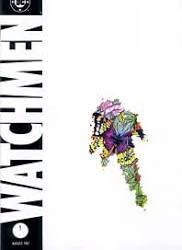
Adrian Veidt, aka Ozymandias, is the character we probably know the least about, and some could argue that leaving it until the penultimate chapter to fill in the gaps is leaving it a little late, but as was the case with Doctor Manhattan and Rorschach, it was important that we got to see the character and his impact on the world of Watchmen before we got the full story. Plus I imagine Alan Moore was very hesitant to give us too many details about Veidt in case he ran the risk of revealing his hand too early and spoiling the twist. Look On My Works, Ye Mighty offers many answers to the burning questions throughout the graphic novel whilst offering us a chilling insight into the last remaining superhero archetype that had been unexplored until now. The ‘liberal’ capitalist.
Up until now, we know precisely three things about Veidt. He’s rich, he’s clever and he’s an innovator. It was his subsidiary companies that utilised Manhattan’s superpowers as an alternate energy source, making America eco-friendly and revolutionising technology at the time. He’s also the one superhero in the novel that the general public actually seem to like. Most likely because of his willingness to reveal his secret identity before the Keene Act was passed outlawing superheroes and using his vast wealth and influence to try and help the world instead of merely donning a costume and beating people up. However he’s not popular among other superheroes, most notably Rorschach and the Comedian. With Rorschach, the reasoning is obvious. He’s right wing and homophobic, so naturally he’s at odds with Adrian from the get go. With the Comedian, it’s his cynical nihilism that prevents him from seeing Adrian as anything other than a naive fool with delusions of grandeur. And the dislike is mutual. Adrian openly dislikes Rorschach and, in this very issue, he condemns the Comedian for being Richard Nixon’s lap dog, accusing him of being behind the assassination of JFK and working to keep Nixon in power beyond his term limits (whether this is actually true or simply the conspiratorial ramblings of a bitter liberal is left intentionally unclear). So it’s very ironic indeed that it was the Comedian that gave Adrian the inspiration to fake an alien invasion in the first place.
Now I have a lot to say about the whole alien squid thing, but I’m going to save that for the last review. For now I simply want to focus on Ozymandias himself and the reasons and motivations behind his actions.

So first things first, what’s with the Egyptian imagery? Well Ozymandias is actually the given name for the historical figure known as Alexander the Great, whom Adrian feels a strong kinship towards. It also ties into Adrian’s personality and goals. Obviously there’s the obscene wealth and ridiculously self indulgent architecture, but also the ancient belief that the pharaohs of Ancient Egypt were intermediaries between the gods and mortals. This is important because it gives us an insight into how Adrian views himself and the world around him. Because of his intellect and his wealth, he views himself as being above humanity and only he knows how best to fix the world. However, in the process, he reduces ordinary people to mere statistics. Killing millions of people in one city will bring about world peace and prosperity for the other billions of people around the globe. This line of thinking is called utilitarianism, which basically means that the ends justify the means. Now of course all the characters in Watchmen display elements of utilitarian thinking, but Adrian takes it a step further, applying his own morality to a global scale. It’s scary on a number of levels, but what makes it so frightening for me is what the character of Ozymandias says about other capitalist superheroes like Batman, Green Arrow and Iron Man.
Rich white men becoming costumed vigilantes is nothing new of course. Batman was one of the first comic book superheroes ever conceived after all. But very rarely do we get to see or explore the political and social implications of a superhero being a member of the one percent. If you think about it, ultra rich men putting on costumes and beating up often working class criminals is quite disturbing. Especially when you consider the kinds of things the mega rich get away with in the real world. Money gives you influence and influence gives you power. Costumed crime fighting is in itself an exercise of power over those deemed immoral, but for the capitalist superhero it’s also power over the impoverished and dispossessed. Class privilege in action. This is something that’s hardly ever touched upon in comics. Okay Iron Man comes the closest at points as he was initially created to critique industrialists and war profiteers, and the Civil War storyline paints him in a very ugly light as the Superhuman Registration Act imposed by the government reveals a strong wealth and class divide within the superhero community, but other than that the conversation is usually swept under the rug.
DC Comics are quick to point out how Batman and Green Arrow aren’t like those rich white men. Look, they’re donating money to orphanages and helping the homeless! They’re nice capitalists! We like those capitalists! As for Marvel, there’s a line even they won’t cross regarding the politics of Iron Man and other such superheroes in their canon. They’re more than happy to discuss how making weapons of mass destruction is bad, but you’ll never see them get too specific. You’ll never see them condemn the American military and the role they’ve played in the destabilisation of the Middle East, nor will you ever see them outright address the distinct possibility that Tony Stark is in fact Republican. This is why I often find the accusation of publishers and movie studios having a quote/unquote ‘political agenda’ so baffling because the truth is they have no agenda other than to make money. Marvel and DC are businesses. They’ll never risk taking a firm stance either way for fear that it will alienate a certain group of readers and lose them sales. But by dodging and skirting around the conversation, the two companies have created an archetype that feels incredibly disingenuous, which is what Watchmen seeks to expose with Ozymandias.
The question is can someone who is ultra rich and influential possibly be heroic? This is something that was briefly touched upon back in A Brother To Dragons with Nite Owl. Dan spent his dad’s inheritance on costumes and gadgets for his superhero alter ego when surely it would have been better to donate the money to charity or something if he truly wanted to help his community. But that’s not what Dan wants. Not really. He just wants to indulge in his own power fantasy. Adrian takes that one step further. He has more money than Dan. Exponentially more. And it can be argued he’s done good things for his community, such as creating renewable energy. However, just like with Dan, the reasoning behind his plot isn’t really down to wanting to help others, but rather as a way of having the ultimate power fantasy. To be seen to be saving the world.

Everything Adrian does is less to do with helping others and more to do with displaying his own power and influence. Don’t get me wrong. I believe that he believes he’s doing the right thing, but if you really scrutinise his actions, his motivations feel far more self serving than he would care to admit. Tricking the world into believing they’re being invaded by an outside force is one thing, but taking the trouble to kidnap multiple scientists, writers and artists in order to create a fake alien seems like overkill. It’s ego driven. If you think about it, a bomb would have done. But Adrian wanted something spectacular. Something memorable. Just look at his decor. He built an entire Egyptian temple and biodome in Antarctica. Why? There’s no reason other than for his own self aggrandisement. It’s a display of his power.
Then there’s his actions regarding the Comedian, Rorschach and Doctor Manhattan. He wanted to get rid of witnesses. Understandable. But why beat the Comedian up so savagely, chucking him from his penthouse window, when he could just as easily have dispatched him with a single gunshot like he did with Moloch? Could it be that silencing the Comedian was less about self preservation and more about Adrian demonstrating his superiority over Nixon’s lap dog? Same goes for Rorschach. Again, he could have just killed him. Would have been much simpler. Instead he frames him for Moloch’s murder. It’s not enough to get rid of Rorschach. He wants the satisfaction of outwitting this right wing sociopath. The manipulation of Doctor Manhattan is self explanatory. Tricking a god into leaving the planet must have been quite the ego boost. And then there’s the fake assassination attempt in Fearful Symmetry. Adrian wanted to deflect suspicion away from him, but like with the alien, he wanted something spectacular. Something memorable.
Every single thing Adrian Veidt does throughout the graphic novel has some sort of egotistical agenda behind it. Even his ultimate plot to stop World War Three and unite the world isn’t about the greater good. It’s about him overcoming his own feelings of powerlessness. Because up until now the one thing he was unable to control with all his wealth and influence was the nukes. Now he’s managed even that. He has succeeded where Alexander the Great failed. He is truly the King of kings.
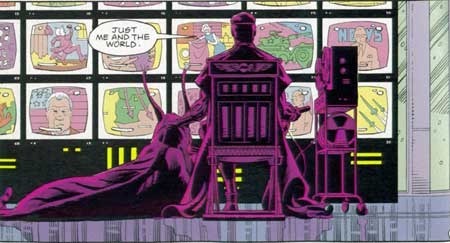
While not as over the top as this, we’ve seen this kind of behaviour so many times before by members of the quote/unquote liberal elite. Bill Gates, JK Rowling, Joss Whedon, Elon Musk and many more. Wealthy people of influence who are more concerned with looking progressive than actually being progressive. They perform charitable acts not out of a genuine desire to help others, but in order to be seen to be charitable. This is Ozymandias. Like I said, I believe that he believes he’s doing the right thing, but for me I think he’s more interested in being seen to have saved the world rather than actually doing something to truly help bridge the divide between nations. In some ways, he represents superheroes as a whole within Watchmen. Men and women more concerned with the attention and power being a superhero brings than actually helping their community. And just as a superhero alter ego allows the characters to see themselves as being above others, so too does wealth allow Adrian to see himself as being above the world.
This is why it was so important to see all the supporting characters. The news vendor, the kid reading the Black Freighter, Joey and her lesbian partner, Doctor Malcolm Long and his wife, and the two police detectives. To remind us that these are real people’s lives these characters are toying around with here. And it’s genuinely unnerving seeing all these people we’ve come to know over the course of the graphic novel be completely obliterated.

15 notes
·
View notes